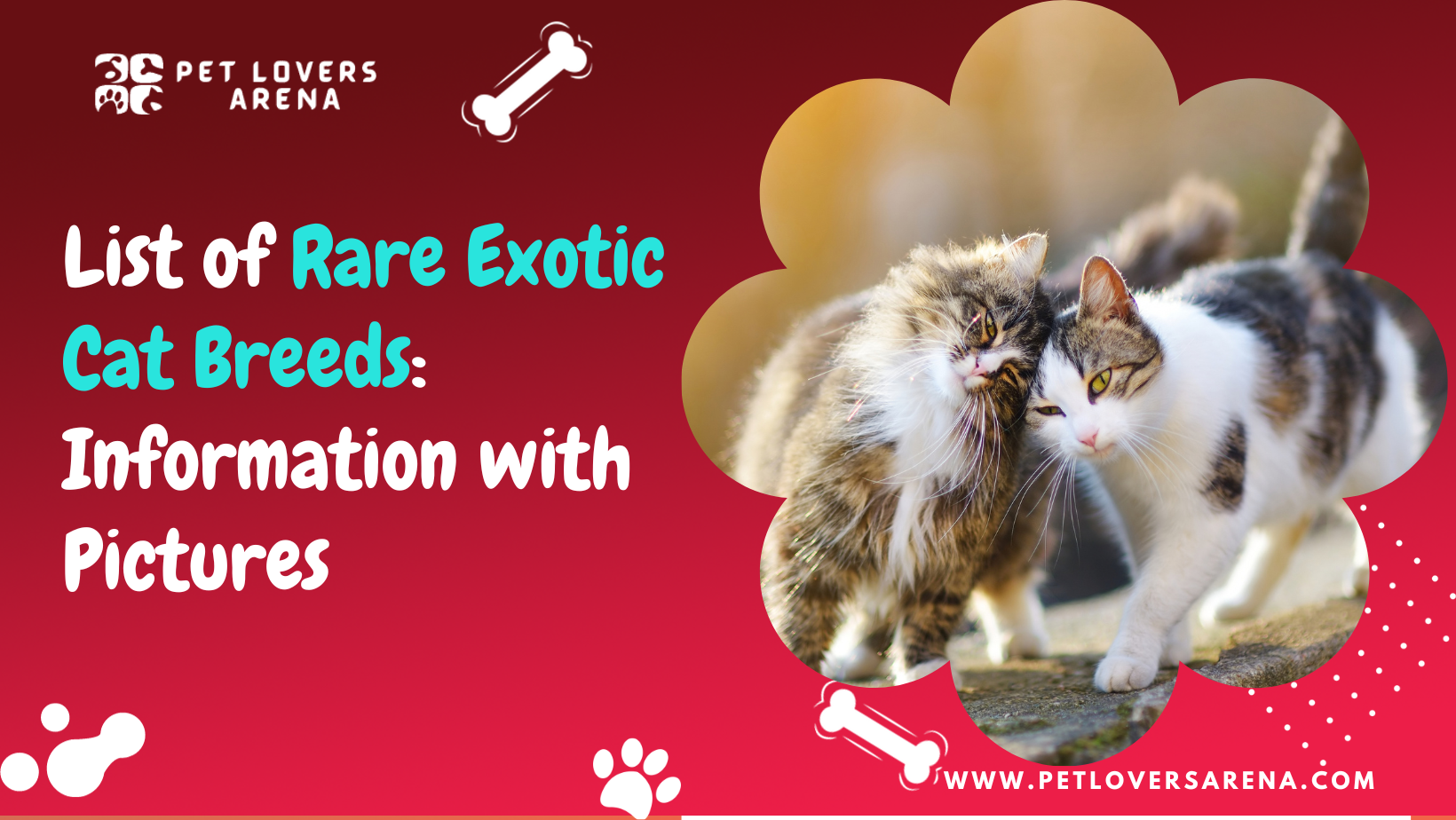If you’re a cat lover, you’re probably familiar with popular breeds like the Persian, Siamese, and Maine Coon. But did you know that many rare and exotic cat breeds are out there waiting to be discovered? These unique cats come in various sizes, colors, and patterns, each with a special personality and temperament.
Some rare exotic cat breeds are the result of genetic mutations, while others are hybrids created by crossing different breeds. Many of these cats are known for being affectionate, playful, and social, making them great family pets. Others are more independent and inquisitive and require plenty of interactive playtime to stay happy and healthy.
In this article, we’ll introduce you to some of the rarest and most unique cat breeds out there, from the energetic and outgoing Savannah Cat to the gentle and curious Nebelung. We’ll provide you with information on each cat’s scientific name, native habitat, size, diet, and lifespan, as well as their special traits and characteristics. So get ready to discover some truly one-of-a-kind feline friends!
Key Takeaways
- There are many rare and exotic cat breeds that are waiting to be discovered.
- These unique cats come in various sizes, colors, and patterns, each with a special personality and temperament.
- From the energetic and outgoing Savannah Cat to the gentle and curious Nebelung, each cat has its own special traits and characteristics.
List of Rare Exotic Cat Breeds
If you’re looking for a unique and exotic feline companion, there are plenty of rare cat breeds to consider. These cats come in all shapes and sizes, with unique coat patterns and personalities that are sure to capture your heart. Here are some of the rarest and most exotic cat breeds you might want to consider:
1. Egyptian Mau
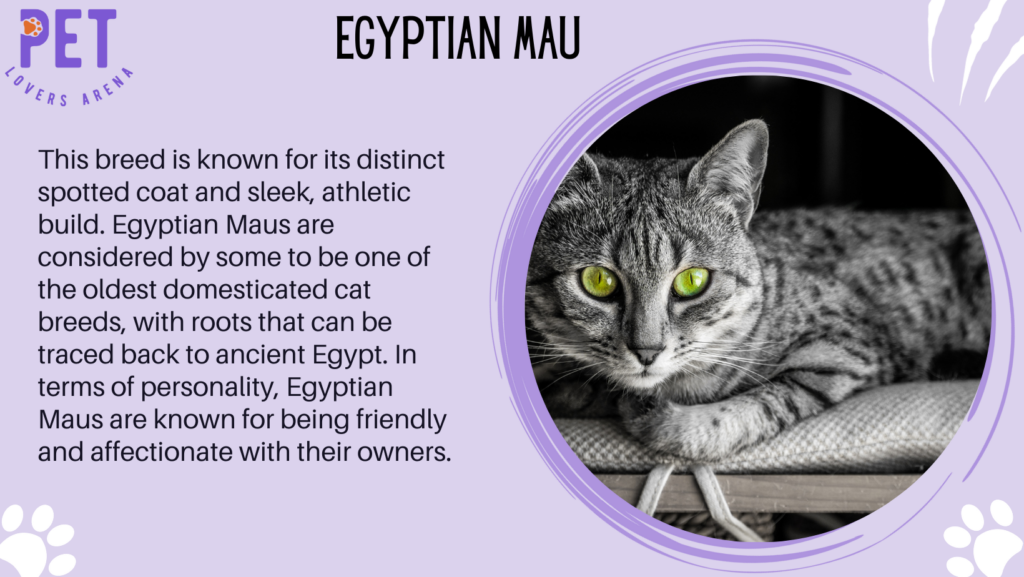
If you’re looking for a rare and exotic cat breed, the Egyptian Mau might be right up your alley. This breed is known for its distinct spotted coat and sleek, athletic build. Egyptian Maus are considered by some to be one of the oldest domesticated cat breeds, with roots that can be traced back to ancient Egypt. In terms of personality, Egyptian Maus are known for being friendly and affectionate with their owners.
- Native Habitat: The Egyptian Mau is believed to have originated in Egypt, where it was worshiped by the ancient Egyptians. Today, the breed can be found all over the world but is still relatively rare outside of Egypt.
- Scientific Name: Felis catus.
- Size: Egyptian Maus are medium-sized cats, with males typically weighing between 10 and 14 pounds and females weighing between 6 and 10 pounds.
- Diet: Egyptian Maus require a high-protein diet to stay healthy. You can feed them a combination of wet and dry food or opt for a raw food diet if that’s your preference. Just be sure to choose high-quality food that is appropriate for their age and activity level.
- Lifespan: The average lifespan for an Egyptian Mau is around 12-14 years.
2. Savannah Cat
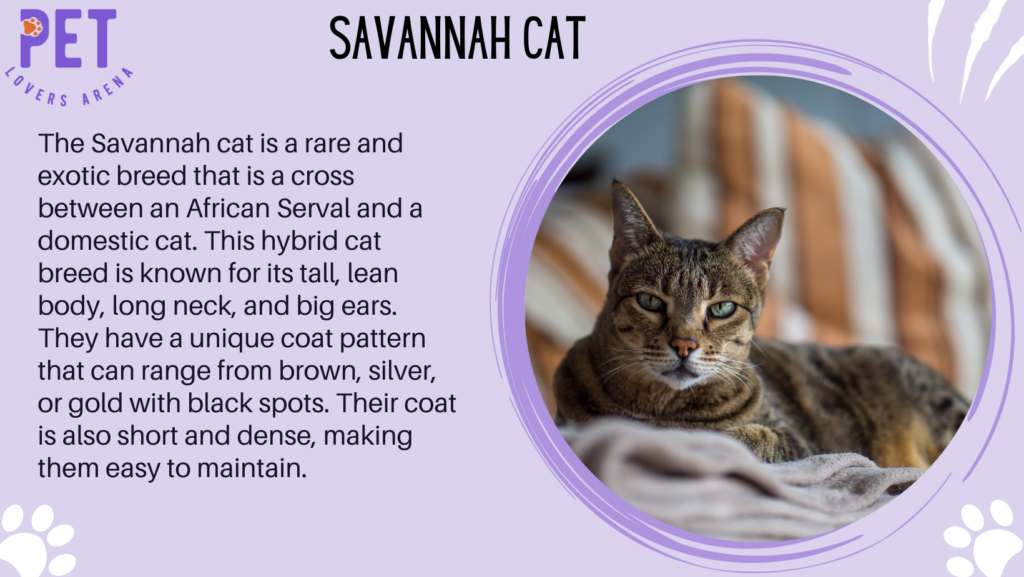
The Savannah cat is a rare and exotic breed that is a cross between an African Serval and a domestic cat. This hybrid cat breed is known for its tall, lean body, long neck, and big ears. They have a unique coat pattern that can range from brown, silver, or gold with black spots. Their coat is also short and dense, making them easy to maintain.
- Native Habitat: They are widespread in Sub-Saharan countries.
- Scientific Name: Felis catus.
- Diet: Savannah cats are carnivores and require a diet that is high in protein. Feeding them a diet that consists of raw or cooked meat is recommended. They should also have access to fresh water at all times.
- Size: Savannah cats are a large-sized breed that can weigh between 15-28 pounds and have a body length of 20-22 inches.
- Lifespan: Savannah cats have a lifespan of 18-20 years.
3. Ocicat
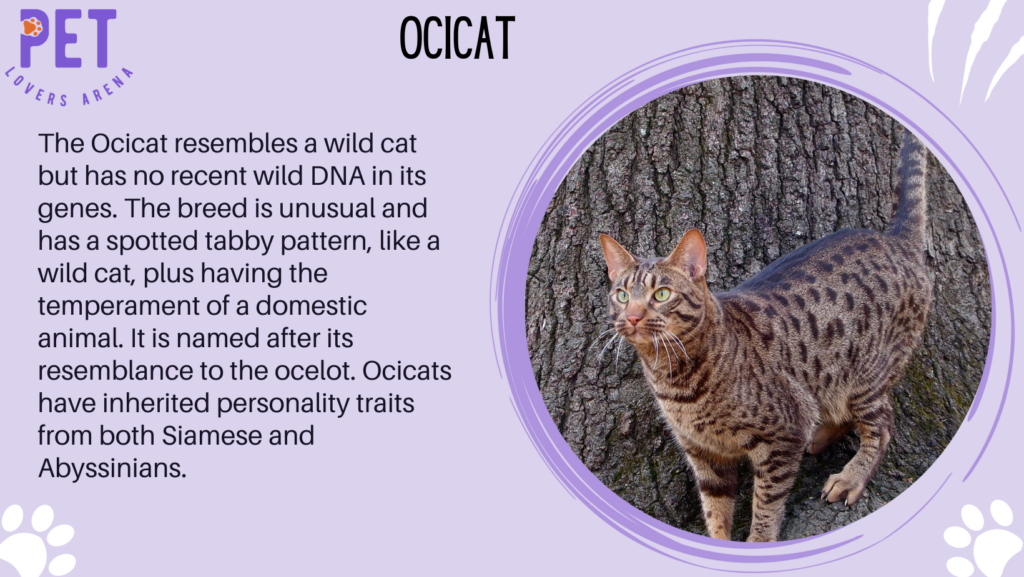
The Ocicat resembles a wild cat but has no recent wild DNA in its genes. The breed is unusual and has a spotted tabby pattern, like a wild cat, plus having the temperament of a domestic animal. It is named after its resemblance to the ocelot. Ocicats have inherited personality traits from both Siamese and Abyssinians, two breeds considered to be domesticated for many thousands of years. They will often greet your guests and are friendly and sociable.
- Native Habitat: The breed was created in the United States in 1964.
- Scientific Name: Felis catus.
- Size: The Ocicat is a medium to large-sized cat breed. They grow to be about 15 pounds, much like a large house cat.
- Diet: The Ocicat is an active breed that requires a balanced diet to maintain health. A high-quality, protein-rich cat food is recommended. It is important to monitor their food intake to prevent obesity.
- Lifespan: The Ocicat has a lifespan of 12-18 years.
4. Peterbald
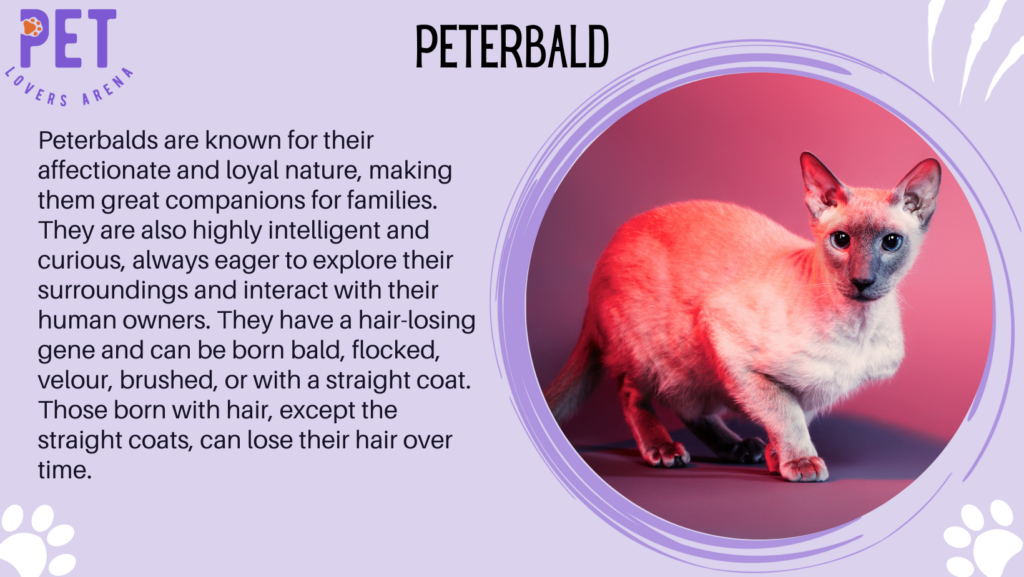
Peterbalds are known for their affectionate and loyal nature, making them great companions for families. They are also highly intelligent and curious, always eager to explore their surroundings and interact with their human owners. They have a hair-losing gene and can be born bald, flocked, velour, brushed, or with a straight coat. Those born with hair, except the straight coats, can lose their hair over time. They come in all colors and markings.
- Native Habitat: Saint Petersburg
- Scientific Name: Felis catus.
- Diet: Peterbalds requires a balanced diet that is high in protein and low in carbohydrates. You can feed them a combination of wet and dry food or a raw food diet if you prefer. Be sure to consult with your veterinarian to determine the best diet for your cat’s individual needs.
- Size: Peterbalds are medium-sized cats, with adult females weighing between 5-7 pounds and males weighing between 8-10 pounds.
- Lifespan: Peterbalds can live for 12-15 years or more.
5. Serengeti
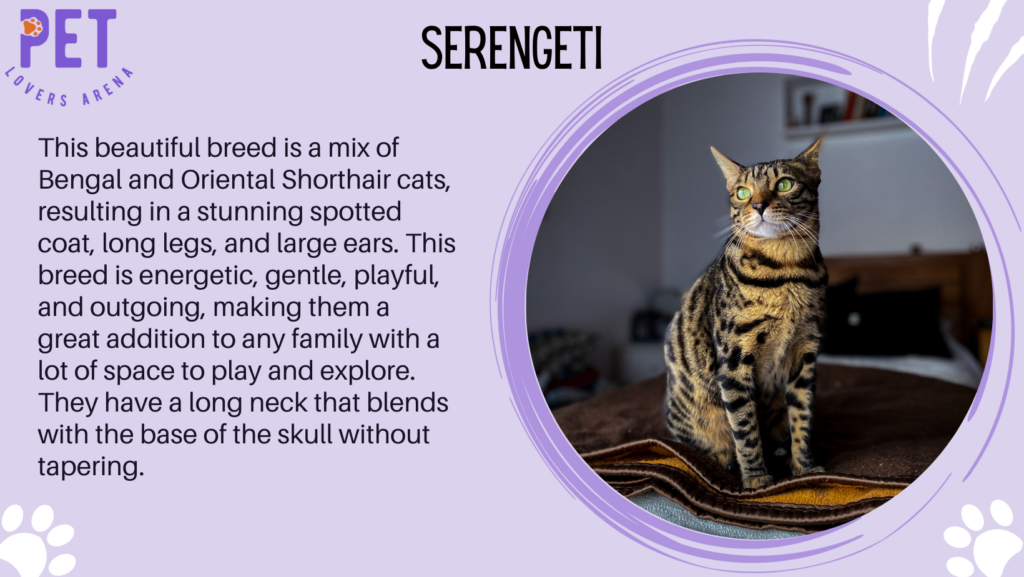
This beautiful breed is a mix of Bengal and Oriental Shorthair cats, resulting in a stunning spotted coat, long legs, and large ears. This breed is energetic, gentle, playful, and outgoing, making them a great addition to any family with a lot of space to play and explore. They have a long neck that blends with the base of the skull without tapering.
- Native Habitat: California
- Scientific Name: Felis catus.
- Diet: Serengeti requires a diet that is high in protein and low in carbohydrates. Feeding them high-quality cat food that meets their nutritional needs is important. You can also include wet food and treats in their diet, but be sure to do so in moderation.
- Size: Serengeti is a medium-sized cat weighing between 8-15 pounds and standing 8-10 inches tall.
- Lifespan: They have a lifespan of 9-15 years.
6. Nebelung
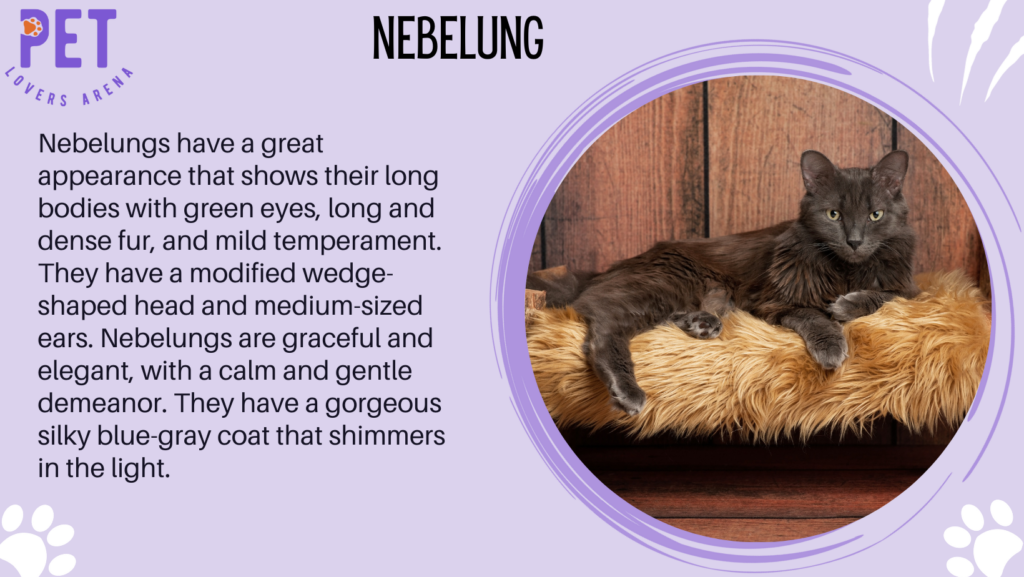
Nebelungs have a great appearance that shows their long bodies with green eyes, long and dense fur, and mild temperament. They have a modified wedge-shaped head and medium-sized ears. Nebelungs are graceful and elegant, with a calm and gentle demeanor. The Nebelung is a relatively new purebred line recognized by the TICA. They have a gorgeous silky blue-gray coat that shimmers in the light.
- Native Habitat: United States in the 1980s.
- Scientific Name: Felis catus.
- Diet: Nebelungs are obligate carnivores, meaning they require a diet high in protein. They should be fed a diet that is primarily made up of meat, such as chicken, turkey, or beef. It is also important to provide them with fresh water at all times.
- Size: Nebelungs are medium-sized cats, typically weighing between 7 and 15 pounds.
- Lifespan: Nebelungs have a lifespan of around 11 to 18 years.
7. Donskoy
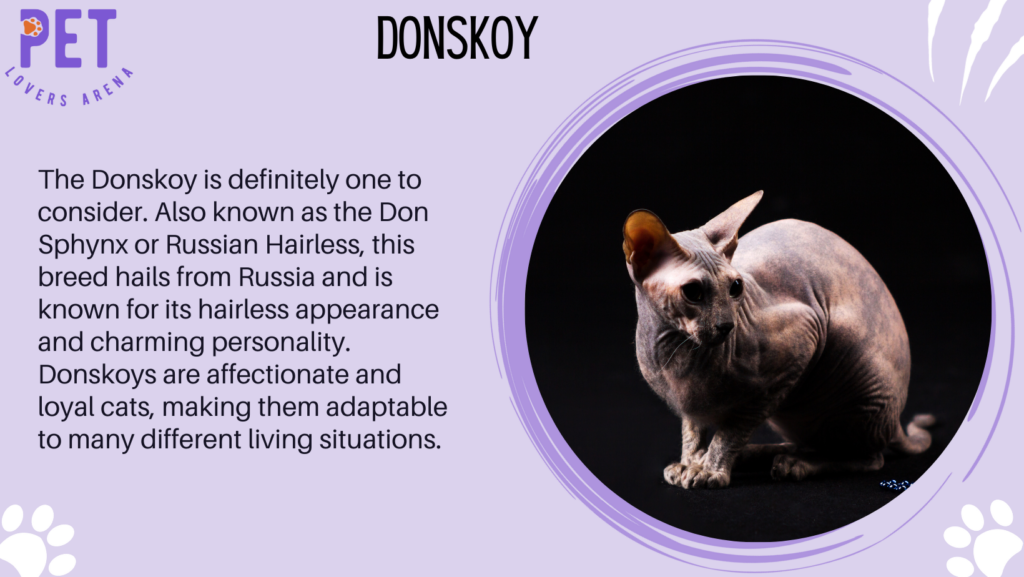
If you’re looking for a unique and distinctive cat breed, the Donskoy is definitely one to consider. Also known as the Don Sphynx or Russian Hairless, this breed hails from Russia and is known for its hairless appearance and charming personality. Donskoys are affectionate and loyal cats, making them adaptable to many different living situations.
- Native Habitat: The Donskoy is originated in Russia.
- Scientific Name: Felis catus.
- Size: Donskoys are medium-sized cats, with males typically weighing between 8 and 12 pounds and females weighing between 6 and 10 pounds.
- Diet: Donskoy’s diet should consist of high-quality, protein-rich food. They should be fed a balanced diet that includes both wet and dry food, and their food should be appropriate for their age and activity level.
- Lifespan: Donskoys have a lifespan of 12 to 15+ years.
8. Snowshoe
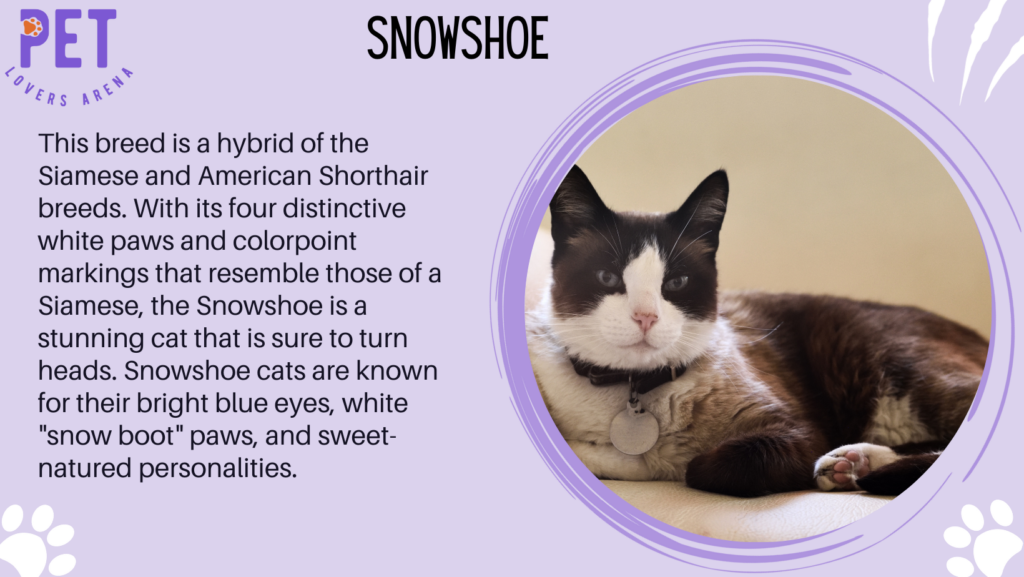
This breed is a hybrid of the Siamese and American Shorthair breeds. With its four distinctive white paws and colorpoint markings that resemble those of a Siamese, the Snowshoe is a stunning cat that is sure to turn heads. Snowshoe cats are known for their bright blue eyes, white “snow boot” paws, and sweet-natured personalities.
- Native Habitat: United States in the 1960s.
- Scientific Name: Felis catus.
- Size: Snowshoe cats are medium to large-sized cats, with males weighing between 9-12 lbs and females weighing between 7-10 lbs.
- Diet: Snowshoes require a balanced diet that is high in protein. It is important to feed your Snowshoe a high-quality cat food that is appropriate for their age and activity level. You can also supplement their diet with treats and occasional wet food.
- Lifespan: Snowshoe cats have an average lifespan of 12-15 years.
9. Ukrainian Levkoy
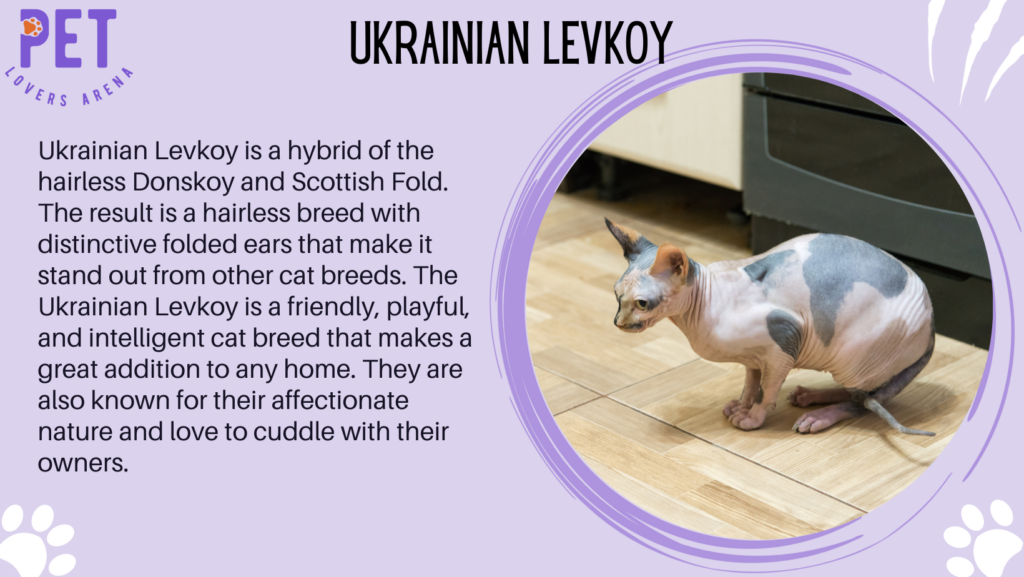
Ukrainian Levkoy is a hybrid of the hairless Donskoy and Scottish Fold. The result is a hairless breed with distinctive folded ears that make it stand out from other cat breeds. The Ukrainian Levkoy is a friendly, playful, and intelligent cat breed that makes a great addition to any home. They are also known for their affectionate nature and love to cuddle with their owners.
- Native Habitat: Ukraine
- Scientific Name: Felis catus.
- Diet: Ukrainian Levkoy requires a balanced and nutritious diet to maintain its health and well-being. It is recommended that they be fed high-quality cat food that is appropriate for their age and activity level. It is also important to provide them with fresh water at all times.
- Size: The Ukrainian Levkoy is a medium-sized cat breed weighing 11 and 15 pounds. They typically stand 8 to 10 inches tall at the shoulder.
- Lifespan: The Ukrainian Levkoy is a relatively healthy breed with a lifespan of 15 to 20 years.
10. Highlander Cat
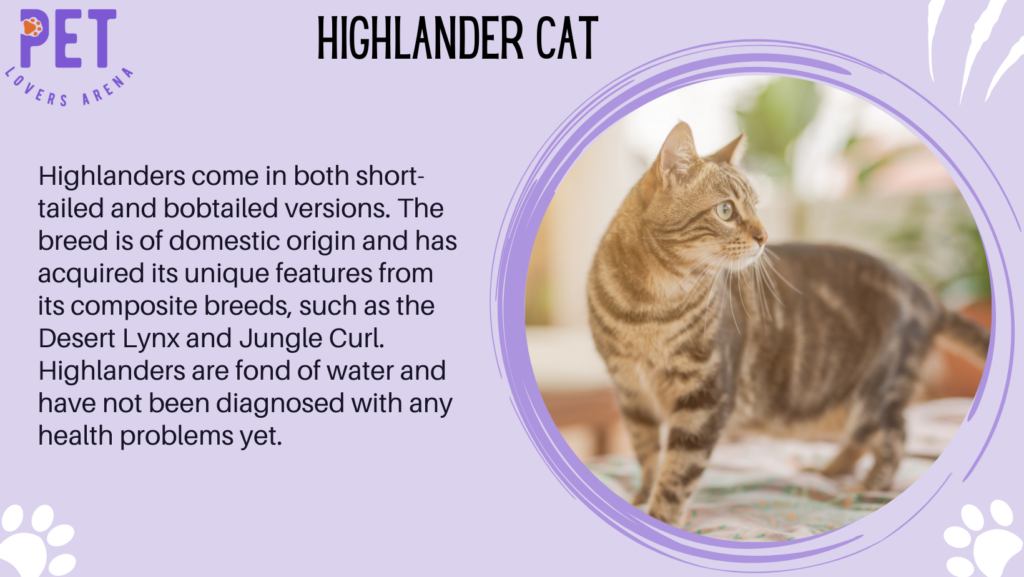
Highlanders come in both short-tailed and bobtailed versions. The breed is of domestic origin and has acquired its unique features from its composite breeds, such as the Desert Lynx and Jungle Curl. Highlanders are fond of water and have not been diagnosed with any health problems yet.
- Native Habitat: United States in the early 2000s.
- Scientific Name: Felis catus.
- Size: Highlander cats are medium to large-sized cats, with males typically weighing between 10-15 pounds and females weighing between 8-12 pounds.
- Diet: Highlander cats are carnivores and require a diet that is high in protein. A high-quality commercial cat food that is specifically formulated for their age, weight, and activity level is recommended. It is also important to ensure that the cat can always access fresh water.
- Lifespan: The average lifespan of a Highlander cat is between 12-15 years.
11. Bambino
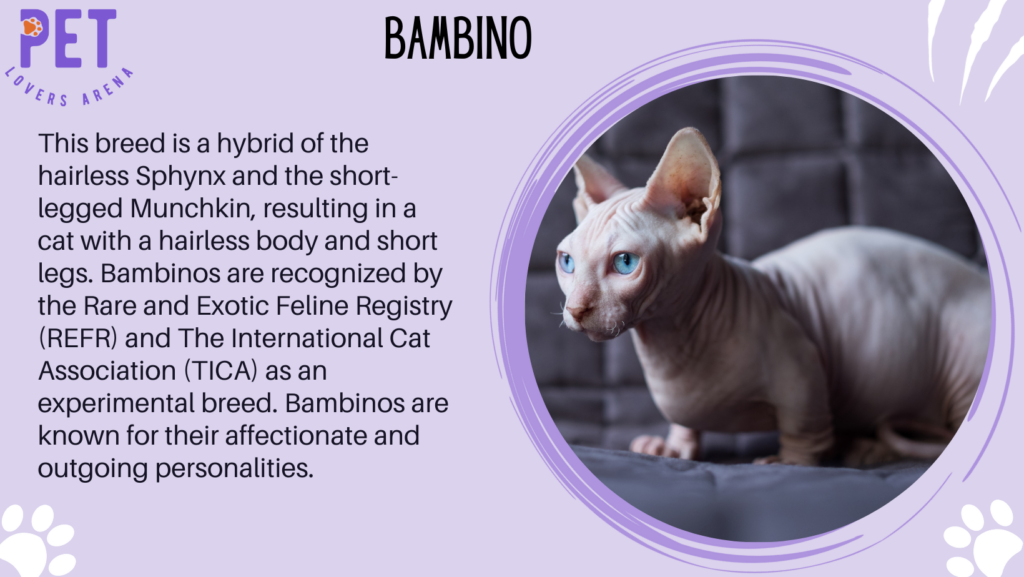
This breed is a hybrid of the hairless Sphynx and the short-legged Munchkin, resulting in a cat with a hairless body and short legs. Bambinos are recognized by the Rare and Exotic Feline Registry (REFR) and The International Cat Association (TICA) as an experimental breed. Bambinos are known for their affectionate and outgoing personalities. They love attention and are great with children and other pets.
- Native Habitat: United States
- Scientific Name: Felis catus
- Size: Bambinos are a small to medium-sized breed, weighing between 5-9 pounds. They have a short, muscular body and short legs.
- Diet: Bambinos require a balanced diet that includes protein, fat, and carbohydrates. You can feed them a commercial cat food or a homemade diet that meets their nutritional needs. Be sure to consult with your veterinarian to determine the best diet for your Bambino.
- Lifespan: Bambinos have a lifespan of around 10-15 years.
12. Arabian Mau
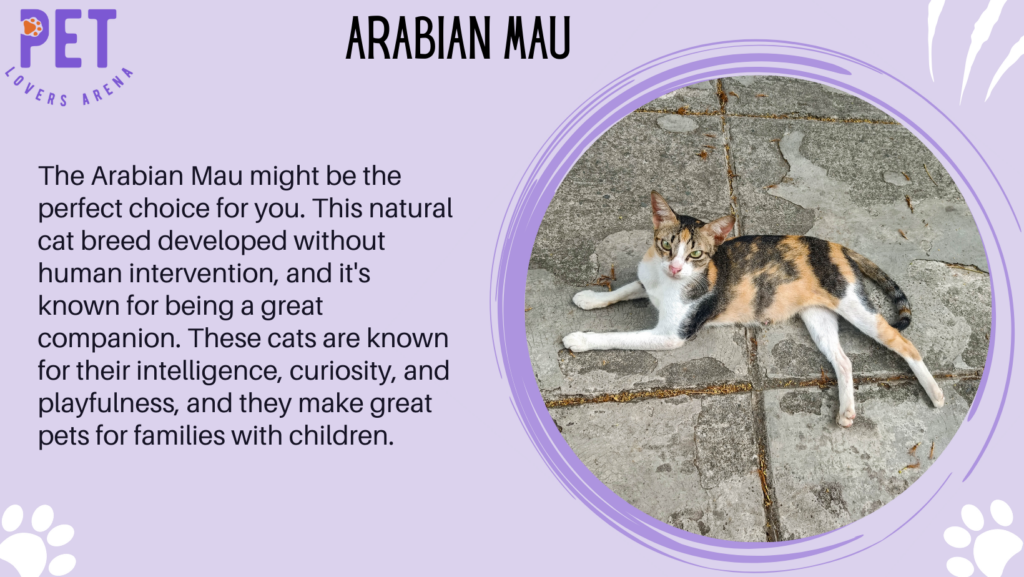
If you’re looking for an energetic, sociable, and playful cat, the Arabian Mau might be the perfect choice for you. This natural cat breed developed without human intervention, and it’s known for being a great companion. These cats are known for their intelligence, curiosity, and playfulness, and they make great pets for families with children.
- Native Habitat: Arabian Peninsula.
- Scientific Name: Felis catus.
- Diet: As with any cat, the Arabian Mau needs a balanced diet to stay healthy. You can feed your cat a combination of wet and dry food, or you can choose to feed them a raw food diet. Make sure to consult with your veterinarian to ensure that your cat is getting all of the nutrients it needs.
- Size: The Arabian Mau is a medium-sized to large cat breed. Males can weigh up to 12 pounds, while females can weigh up to 8 pounds.
- Lifespan: The average lifespan of an Arabian Mau is around 15 years.
13. Chausie
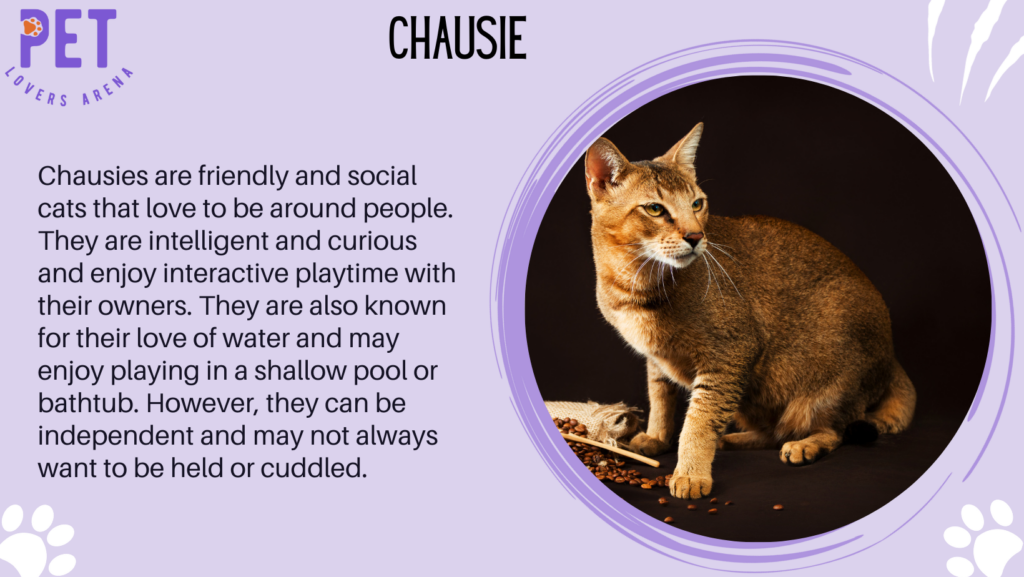
Despite their wild appearance, Chausies are friendly and social cats that love to be around people. They are intelligent and curious and enjoy interactive playtime with their owners. They are also known for their love of water and may enjoy playing in a shallow pool or bathtub. However, they can be independent and may not always want to be held or cuddled.
- Scientific name: Felis chaus x Felis catus
- Native habitat: United States.
- Size: Chausies are a medium to large-sized breed, with males typically weighing between 15-20 pounds and females weighing between 10-15 pounds.
- Diet: A high-quality diet is essential for the Chausie’s health and well-being. They are carnivores and require a diet high in protein with limited carbohydrates.
- Lifespan: Chausies have a lifespan of around 12-14 years.
14. Toyger
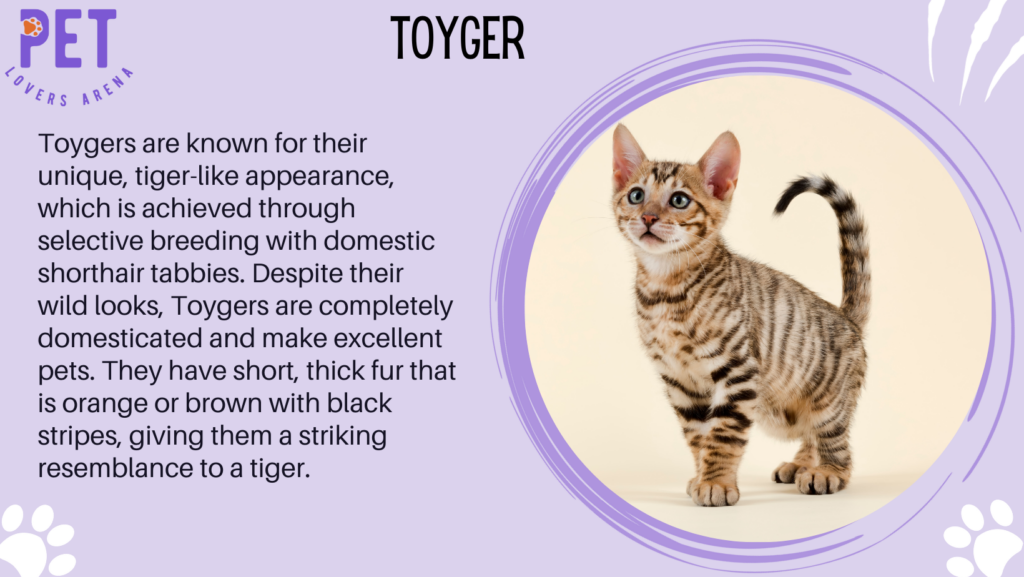
Toygers are known for their unique, tiger-like appearance, which is achieved through selective breeding with domestic shorthair tabbies. Despite their wild looks, Toygers are completely domesticated and make excellent pets. They have short, thick fur that is orange or brown with black stripes, giving them a striking resemblance to a tiger. Toygers have muscular bodies and a long, thick tail.
- Scientific Name: Felis catus.
- Native Habitat: United States
- Size: Toygers are medium-sized cats that typically weigh between 8-15 pounds.
- Diet: Toygers should be fed a high-quality, protein-rich diet that is appropriate for their age and activity level. It is important to avoid overfeeding Toygers, as they can be prone to obesity.
- Lifespan: The average lifespan of a Toyger is around 12-15 years.
15. Bengal
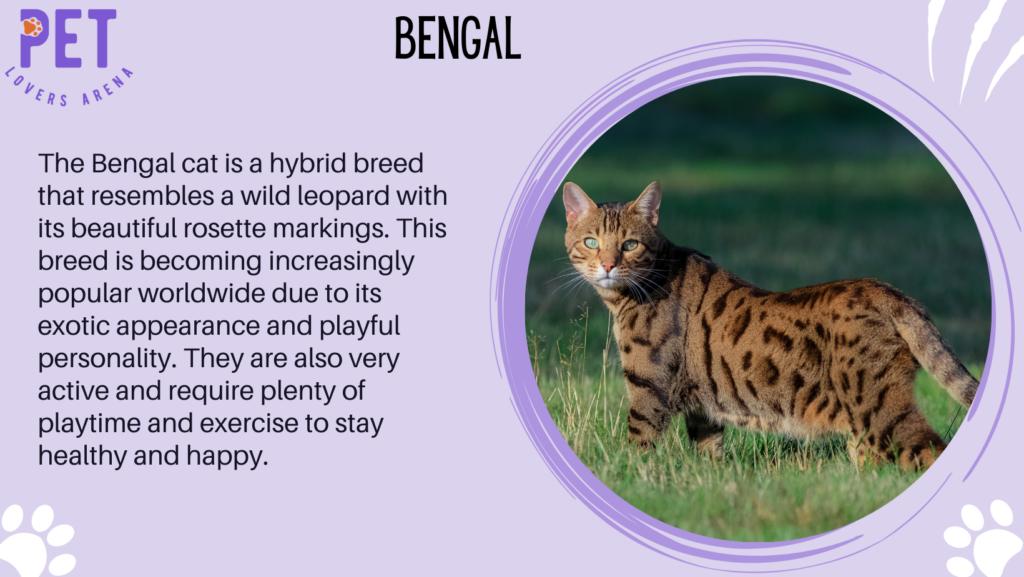
The Bengal cat is a hybrid breed that resembles a wild leopard with its beautiful rosette markings. This breed is becoming increasingly popular worldwide due to its exotic appearance and playful personality. They are also very active and require plenty of playtime and exercise to stay healthy and happy. Bengal cats have short, glossy coat that comes in brown or seal colors with tabby, ticking, and spot patterns.
- Native Habitat: United States
- Scientific Name: Felis catus.
- Size: Bengal cats are medium-sized cats, weighing between 8 and 15 pounds. They have a muscular build and a long, lean body.
- Diet: Bengal cats require a diet that is high in protein and low in carbohydrates. They are obligate carnivores, which means that they need meat to survive. A high-quality, grain-free cat food is recommended for this breed. Providing plenty of fresh water for your Bengal cat is also important.
- Lifespan: Bengal cats have a lifespan of 12 to 16 years.
16. LaPerm
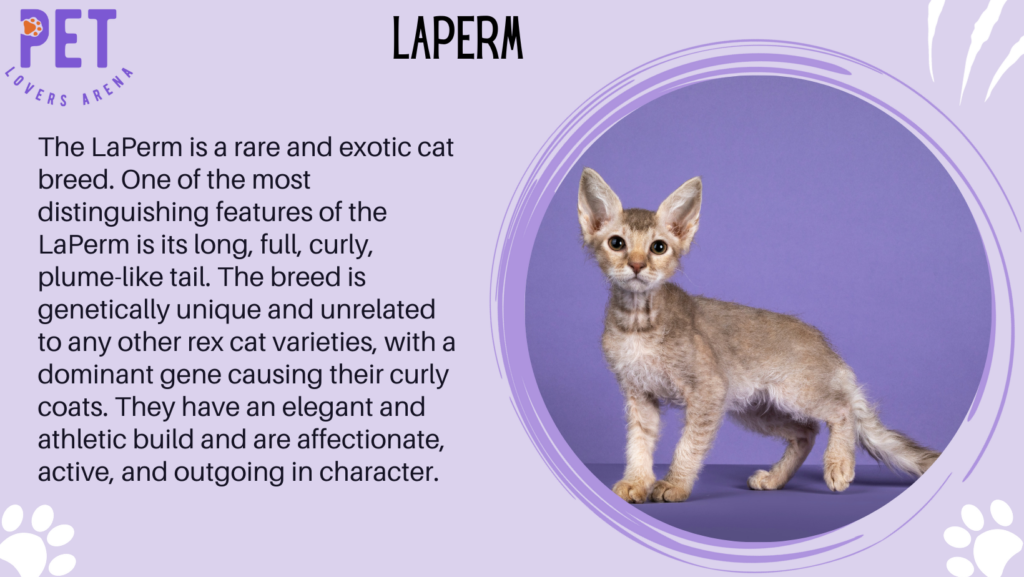
The LaPerm is a rare and exotic cat breed. One of the most distinguishing features of the LaPerm is its long, full, curly, plume-like tail. The breed is genetically unique and unrelated to any other rex cat varieties, with a dominant gene causing their curly coats. They have an elegant and athletic build and are affectionate, active, and outgoing in character.
- Native Habitat: United States.
- Scientific Name: Felis catus.
- Size: 6 to 10 inches
- Diet: LaPerms require a balanced and nutritious diet to maintain their health and well-being. A high-quality protein, fats, and carbohydrates diet is essential for their growth and development. Feeding them a diet of wet and dry food is recommended to ensure they are getting all the necessary nutrients.
- Lifespan: LaPerms have a lifespan of 10-15 years.
17. Sphynx
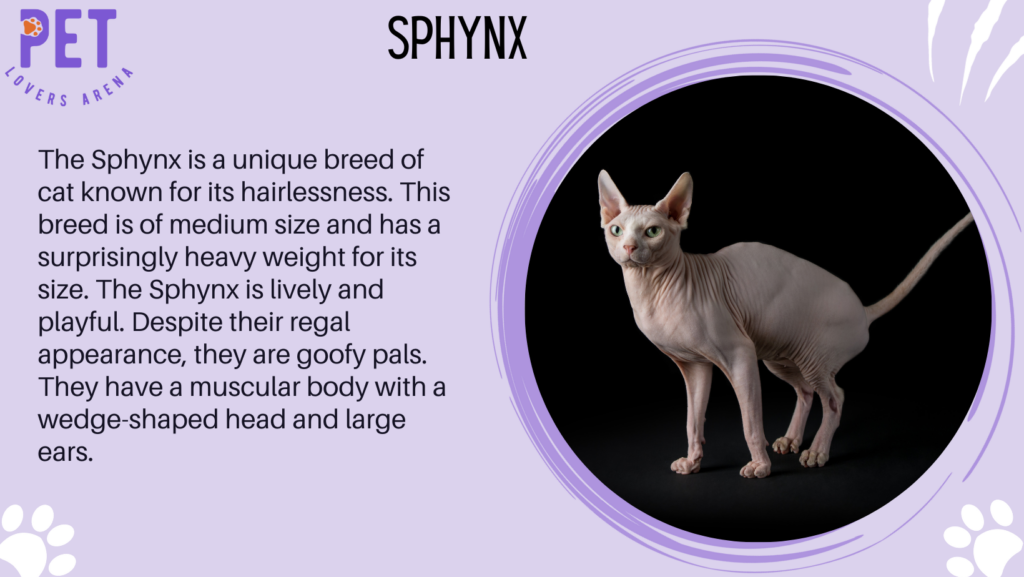
The Sphynx is a unique breed of cat known for its hairlessness. This breed is of medium size and has a surprisingly heavy weight for its size. The Sphynx is lively and playful. Despite their regal appearance, they are goofy pals. They have a muscular body with a wedge-shaped head and large ears. Their eyes are large and lemon-shaped, and they have a long, whip-like tail.
- Native Habitat: Toronto and Minnesota.
- Scientific Name: Felis catus.
- Diet: As with any cat, a balanced diet is essential to the health and well-being of a Sphynx. They require high-quality cat food that provides all of the necessary nutrients for their growth and development. It is important to monitor their weight and adjust their diet accordingly to prevent obesity.
- Size: The Sphynx is a medium-sized cat, with males weighing between 8-12 pounds and females weighing between 6-8 pounds on average.
- Lifespan: The Sphynx has an average lifespan of 8-14 years. With proper care and attention, they can live a long and healthy life.
18. Devon Rex
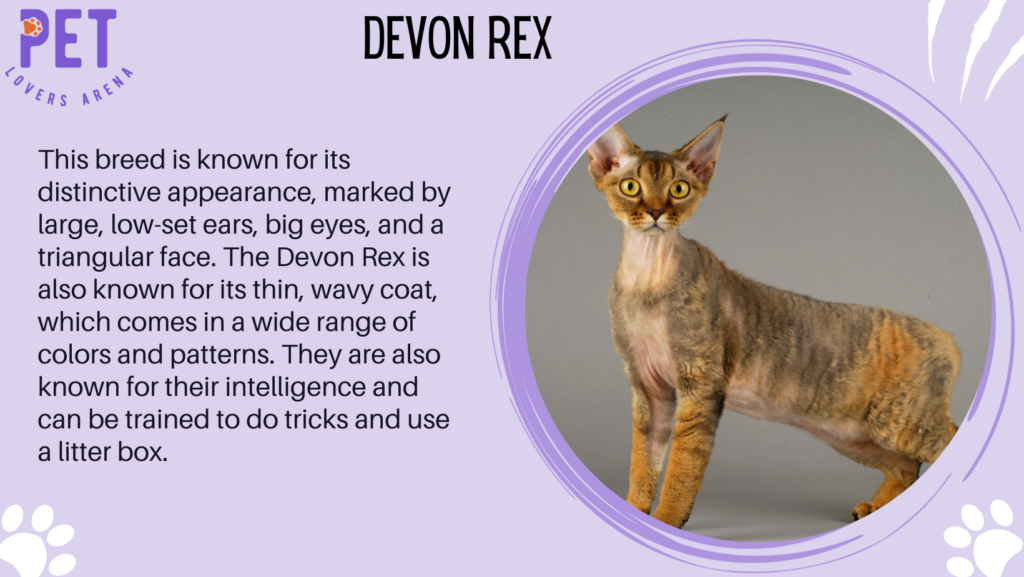
This breed is known for its distinctive appearance, marked by large, low-set ears, big eyes, and a triangular face. The Devon Rex is also known for its thin, wavy coat, which comes in a wide range of colors and patterns. They are also known for their intelligence and can be trained to do tricks and use a litter box.
- Native Habitat: Devonshire, England.
- Scientific Name: Felis catus
- Size: The Devon Rex is a medium-sized cat breed, with males typically weighing between 6 and 9 pounds and females weighing between 5 and 7 pounds.
- Diet: It’s important to provide your Devon Rex with a balanced and nutritious diet. This breed does well on a portion of high-quality cat food that is formulated for their specific nutritional needs. You may also want to consider feeding your Devon Rex a combination of wet and dry food to ensure they are getting enough moisture in their diet.
- Lifespan: The Devon Rex has an average lifespan of 9 to 15 years.
19. Maine Coon
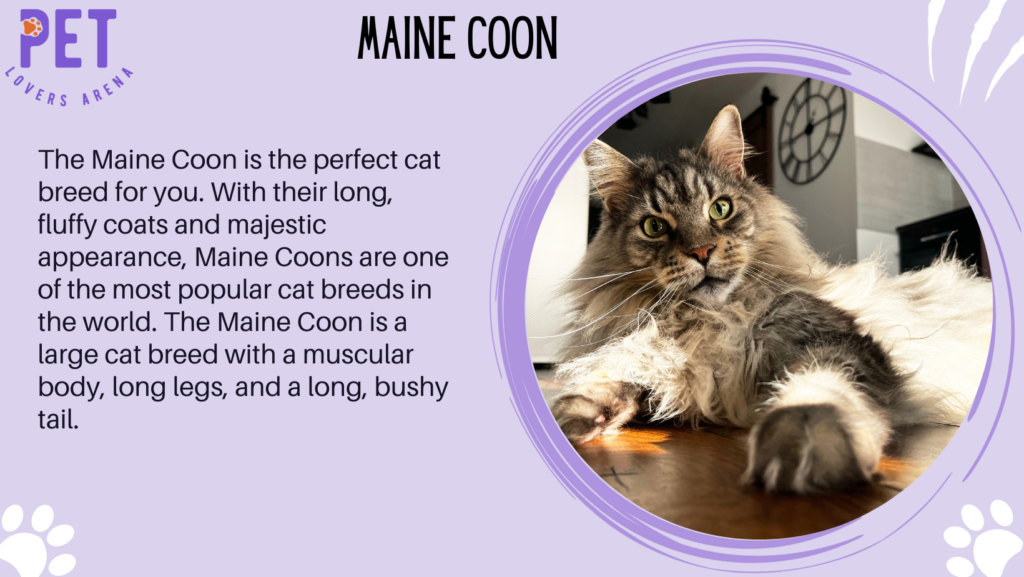
If you’re looking for a gentle giant, the Maine Coon is the perfect cat breed for you. With their long, fluffy coats and majestic appearance, Maine Coons are one of the most popular cat breeds in the world. The Maine Coon is a large cat breed with a muscular body, long legs, and a long, bushy tail.
- Native Habitat: North America, specifically in the northeastern United States.
- Scientific Name: Felis catus.
- Size: Maine Coons are one of the largest domestic cat breeds, with males weighing between 13-18 pounds and females weighing between 8-12 pounds.
- Diet: Maine Coons have a hearty appetite and require a balanced diet to maintain their health. A high-quality, protein-rich diet and plenty of fresh water are recommended. It’s important to monitor their food intake to prevent obesity, which can lead to health problems.
- Lifespan: Maine Coons have a relatively long lifespan, with an average lifespan of 12-15 years.
20. Persian
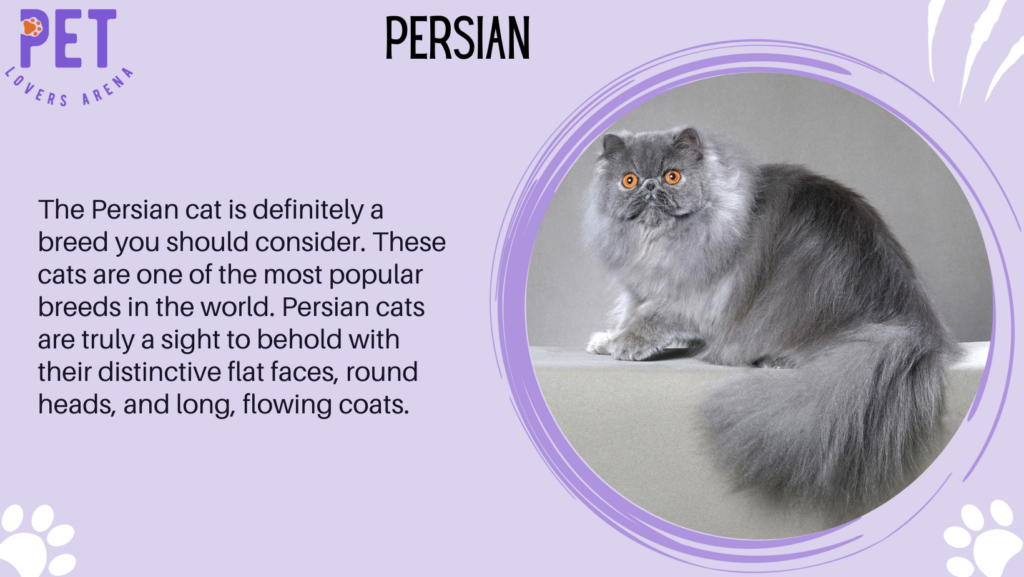
If you are looking for a cat breed that is known for its luxurious, silky fur, then the Persian cat is definitely a breed you should consider. These cats are one of the most popular breeds in the world. Persian cats are truly a sight to behold with their distinctive flat faces, round heads, and long, flowing coats.
- Scientific Name: Felis catus
- Native Habitat: Persia (Iran)
- Size: Medium to large, weighing between 7 to 12 pounds
- Diet: Persians are not particularly active cats, so they do not require a lot of calories. However, they do need a high-quality diet that is rich in protein and other essential nutrients.
- Lifespan: Persians typically live between 12 and 17 years.
21. Sokoke
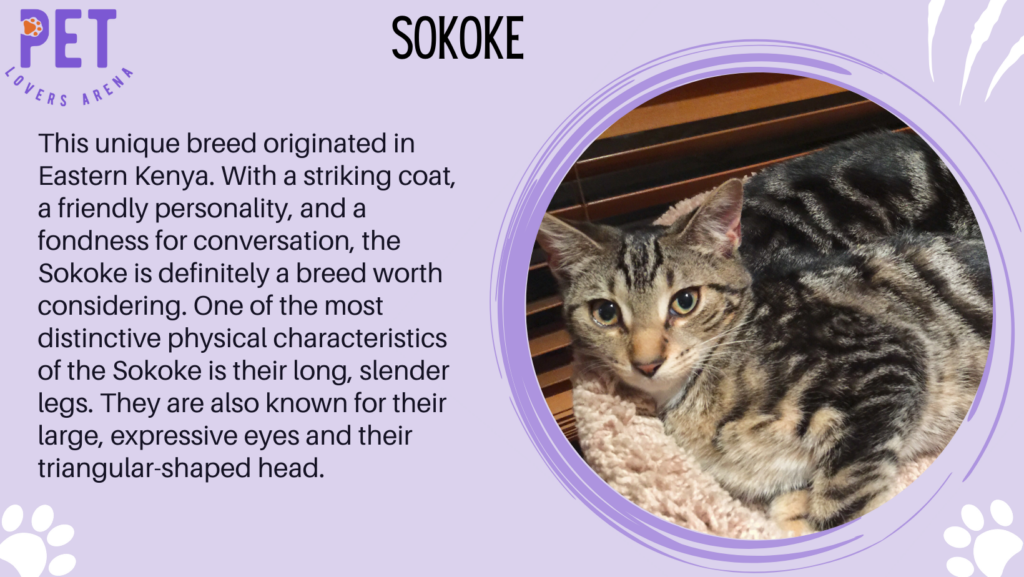
Also known as the Sokoke Forest cat or the African Shorthair, this unique breed originated in Eastern Kenya. With a striking coat, a friendly personality, and a fondness for conversation, the Sokoke is definitely a breed worth considering. One of the most distinctive physical characteristics of the Sokoke is their long, slender legs. They are also known for their large, expressive eyes and their triangular-shaped head.
- Native Habitat: Kenya.
- Scientific Name: Felis catus.
- Diet: The Sokoke is a carnivorous animal, which means that its diet consists primarily of meat. In the wild, they would hunt small rodents and birds, but as pets, they can be fed a diet of high-quality cat food that is rich in protein.
- Size: The Sokoke is a medium-sized cat, with males typically weighing between 8-10 pounds and females weighing between 6-8 pounds.
- Lifespan: They have a lifespan of around 12-15 years.
22. American Wirehair

If you’re looking for a rare and unique cat breed, the American Wirehair may be just what you’re looking for. This breed is relatively new and still quite rare, but it’s definitely worth considering if you’re looking for a cat with a distinctive look and personality. The American Wirehair is a spontaneous mutation of the American Shorthair.
- Native Habitat: New York
- Scientific Name: Felis catus.
- Diet: American Wirehair needs a balanced diet that includes protein, fat, and carbohydrates. You can feed your cat high-quality commercial cat food or prepare a balanced homemade diet. Be sure to consult with your veterinarian to determine the best diet for your cat’s individual needs.
- Size: The American Wirehair is a medium-large breed that can weigh between 8 and 15 pounds.
- Lifespan: This breed has a lifespan of around 12-15 years.
23. Ashera
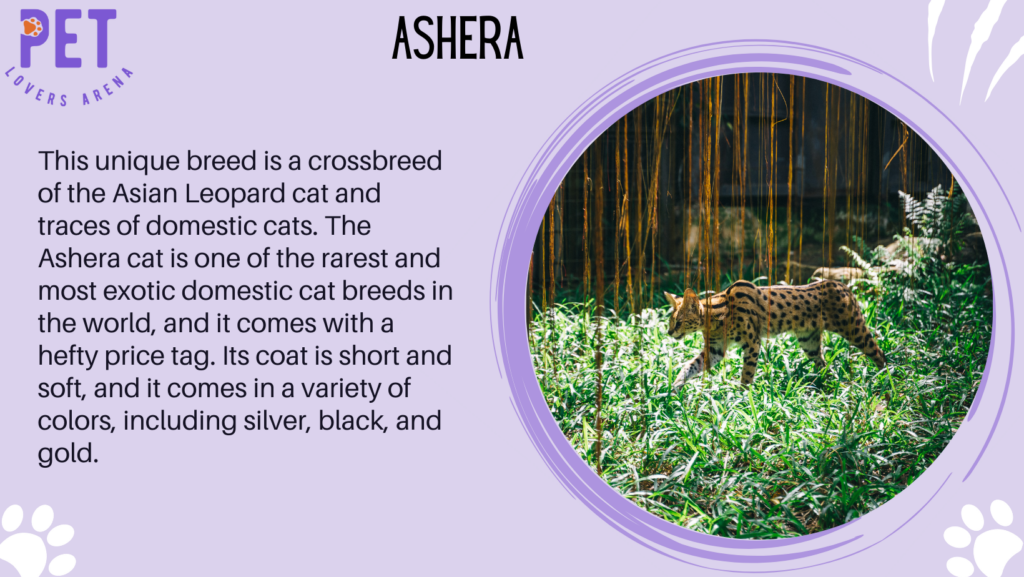
If you are looking for a rare and exotic cat breed, the Ashera cat might be just what you need. This unique breed is a crossbreed of the Asian Leopard cat and traces of domestic cats. The Ashera cat is one of the rarest and most exotic domestic cat breeds in the world, and it comes with a hefty price tag. Its coat is short and soft, and it comes in a variety of colors, including silver, black, and gold. The Ashera cat has bright, almond-shaped eyes, usually green or gold.
- Native Habitat: Africa and Asia.
- Scientific Name: Felis catus.
- Diet: The Ashera cat is a carnivorous animal, meaning it needs a diet high in protein. You should feed your Ashera cat a diet consisting of high-quality cat food and some raw meat and bones.
- Size: The Ashera cat is a large cat breed, and it can weigh up to 30 pounds.
- Lifespan: The Ashera cat has a lifespan of around 12 to 15 years.
24. American Bobtail
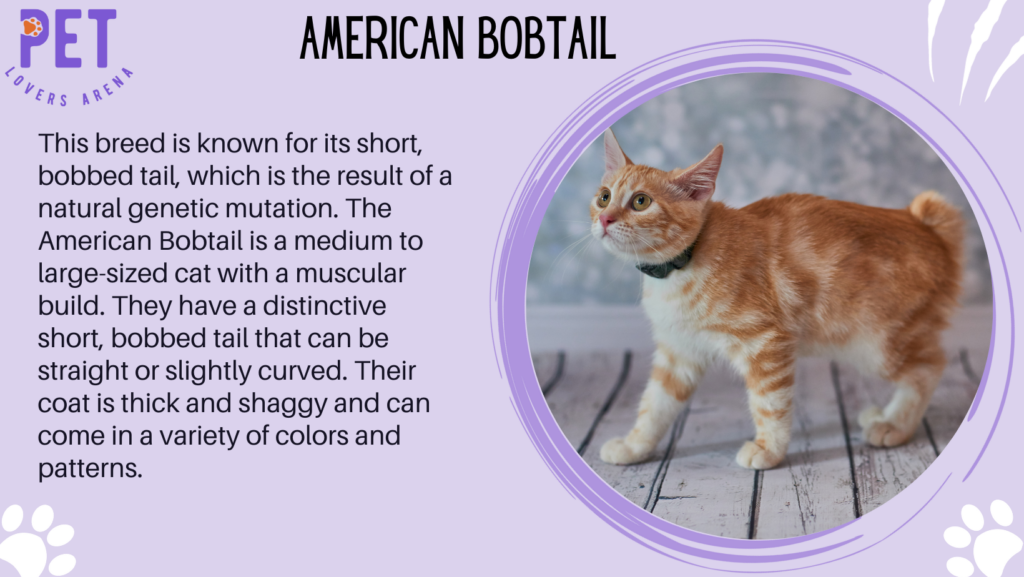
This breed is known for its short, bobbed tail, which is the result of a natural genetic mutation. The American Bobtail is a medium to large-sized cat with a muscular build. They have a distinctive short, bobbed tail that can be straight or slightly curved. Their coat is thick and shaggy and can come in a variety of colors and patterns.
- Native Habitat: United States
- Scientific Name: Felis catus
- Size: American Bobtails are medium to large-sized cats, with males typically weighing between 12 and 16 pounds and females weighing between 7 and 12 pounds.
- Diet: Like all cats, the American Bobtail is a carnivore and requires a diet that is high in protein. You should feed your American Bobtail a diet that includes high-quality animal-based proteins, such as chicken, turkey, and fish.
- Lifespan: The American Bobtail is a relatively healthy breed, with a lifespan of around 13 to 15 years.
25. Balinese
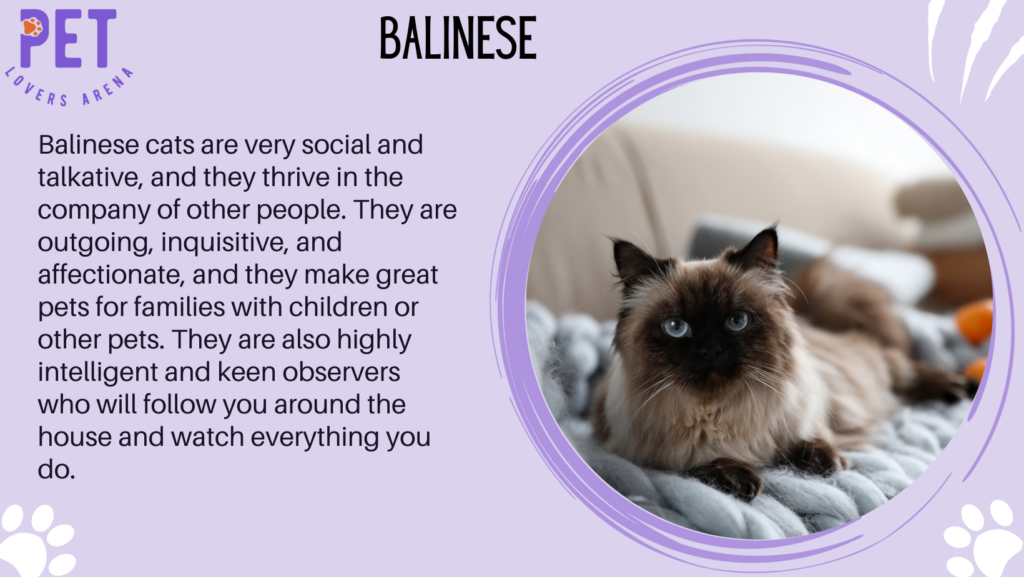
Balinese cats are very social and talkative, and they thrive in the company of other people. They are outgoing, inquisitive, and affectionate, and they make great pets for families with children or other pets. They are also highly intelligent and keen observers who will follow you around the house and watch everything you do.
- Native Habitat: United States
- Scientific Name: Felis catus.
- Size: Balinese cats are medium-sized, with adult females ranging from small to medium and weighing approximately 5-8 pounds. Adult males are typically medium-sized and weigh around 8-12 pounds.
- Diet: Balinese cats have the same dietary needs as any other domestic cat. They require a high-quality, protein-rich diet that is appropriate for their age, weight, and activity level. It is important to feed them a balanced diet that includes both wet and dry food and to provide them with plenty of fresh water.
- Lifespan: The average lifespan of a Balinese cat is around 12-15 years.
26. Bombay
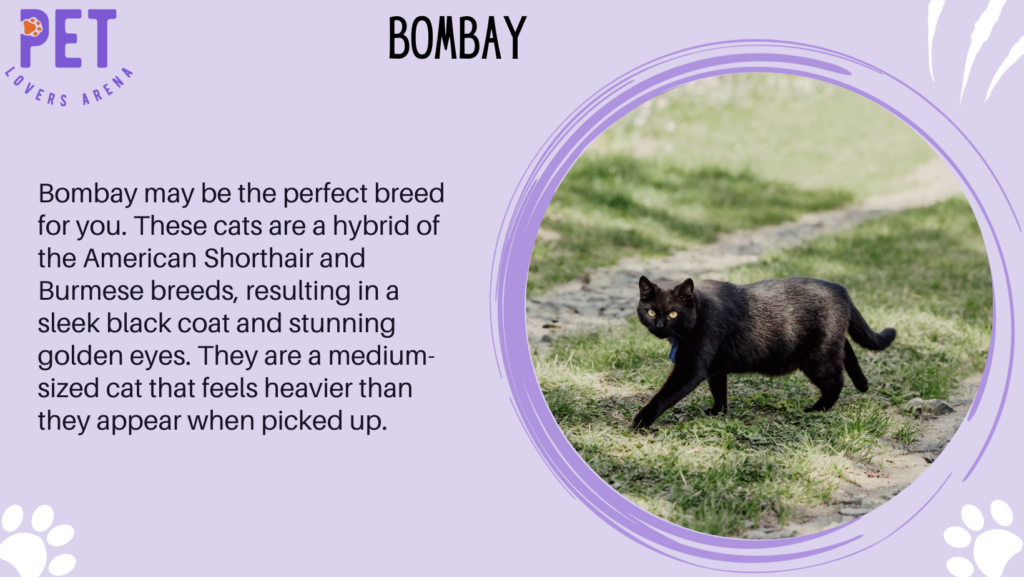
If you’re looking for a cat that resembles a miniature panther, Bombay may be the perfect breed for you. These cats are a hybrid of the American Shorthair and Burmese breeds, resulting in a sleek black coat and stunning golden eyes. They are a medium-sized cat that feels heavier than they appear when picked up.
- Native Habitat: United States.
- Scientific Name: Felis catus.
- Size: Bombay cats are a medium-sized breed, typically weighing between 6-10 pounds.
- Diet: As with all cats, it’s important to feed your Bombay a balanced diet that meets their nutritional needs. High-quality dry and wet cat food is recommended, along with occasional treats. Consult with your veterinarian to determine the best diet for your cat’s individual needs.
- Lifespan: Bombay cats have a lifespan of 12-16 years on average.
27. Burmilla
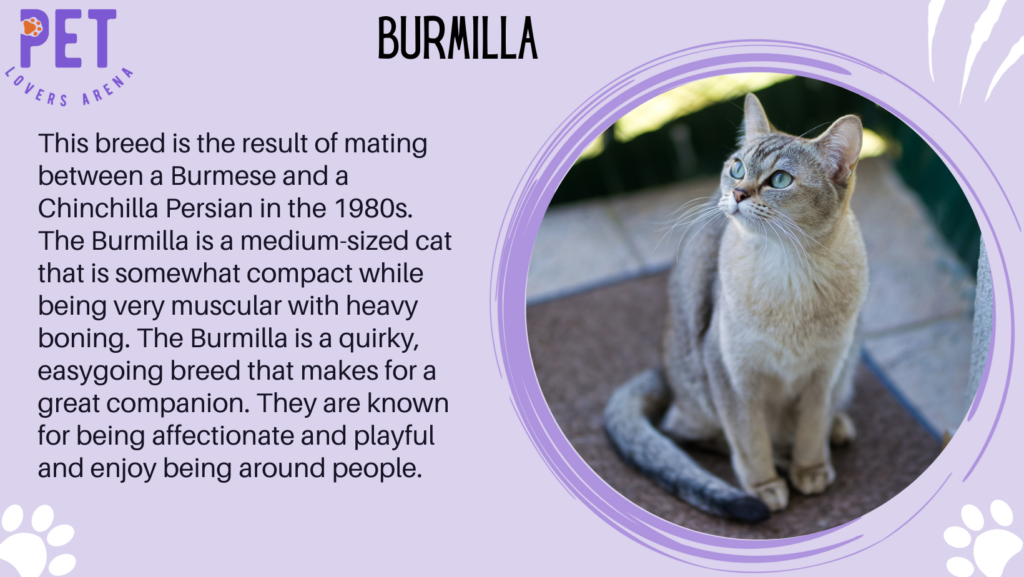
This breed is the result of mating between a Burmese and a Chinchilla Persian in the 1980s. The Burmilla is a medium-sized cat that is somewhat compact while being very muscular with heavy boning. The Burmilla is a quirky, easygoing breed that makes for a great companion. They are known for being affectionate and playful and enjoy being around people. In addition, their paw pads correspond to the coat coloring: Black Silver cats have black or dark brown paw pads, Brown has dark brown, Chocolate has pinkish brown, Blues have Blue-grey, and Lilacs have Dove grey tinged with pink.
- Native Habitat: United States
- Scientific Name: Felis catus.
- Diet: As with any cat breed, feeding your Burmilla a healthy and balanced diet is important. This breed requires a diet that is high in protein and low in carbohydrates. You can feed your Burmilla a combination of wet and dry food, or you can choose to feed them a raw diet. Be sure to talk to your veterinarian about the best diet for your cat.
- Size: The Burmilla is a medium-sized cat, with males weighing between 8-12 lbs and females weighing between 8-12 lbs.
- Lifespan: The Burmilla has a relatively long lifespan, with a range of 7-12 years.
28. Cornish Rex
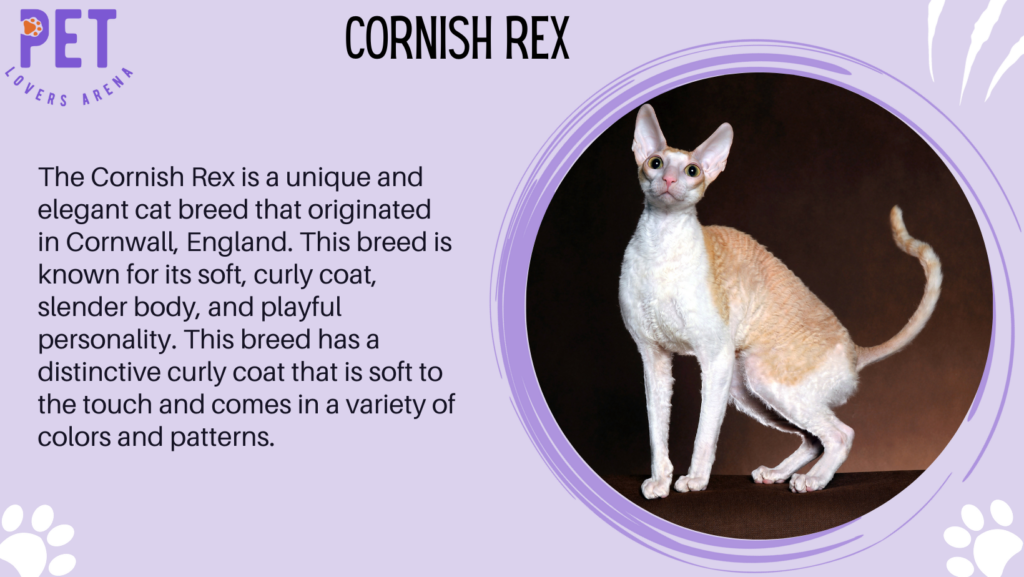
The Cornish Rex is a unique and elegant cat breed that originated in Cornwall, England. This breed is known for its soft, curly coat, slender body, and playful personality. If you’re looking for a cat that is both affectionate and energetic, the Cornish Rex may be the perfect choice for you.
The Cornish Rex is a small to medium-sized cat breed that typically weighs between 6 and 10 pounds. This breed has a distinctive curly coat that is soft to the touch and comes in a variety of colors and patterns.
- Native Habitat: Cornwall, England.
- Scientific Name: Felis catus.
- Diet: Cornish Rex requires a balanced diet that is rich in protein and other essential nutrients. It is important to feed your Cornish Rex a high-quality cat food that is appropriate for their age and activity level. You can also supplement their diet with treats and occasional table scraps, but be careful not to overfeed them.
- Size: The Cornish Rex is a small to medium-sized cat breed that typically weighs between 6 and 10 pounds.
- Lifespan: The Cornish Rex has an average lifespan of 11-15 years.
29. Colorpoint Shorthair
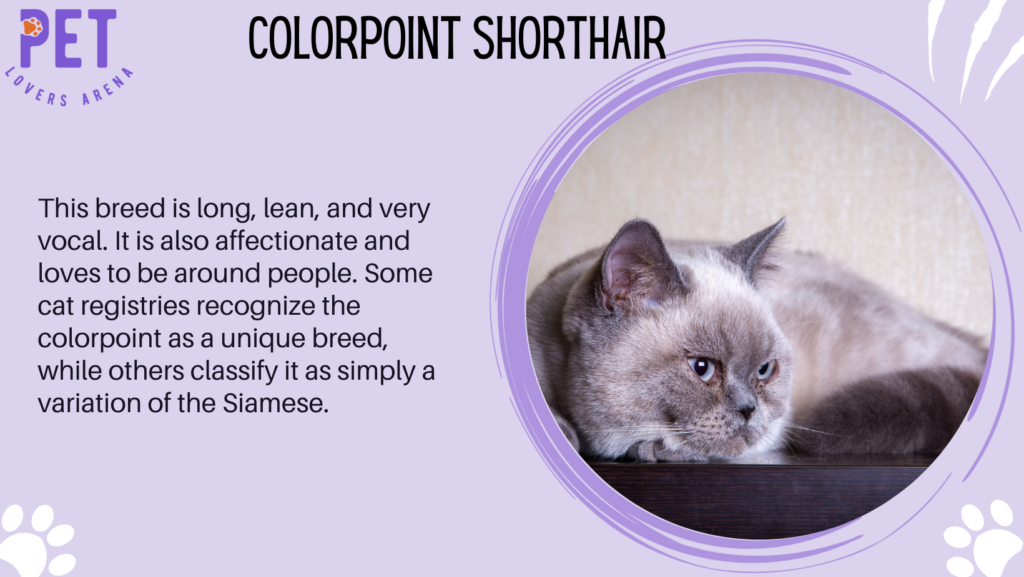
If you are looking for a cat breed hybrid of Siamese and American Shorthair, you might want to consider the Colorpoint Shorthair. This breed is long, lean, and very vocal. It is also affectionate and loves to be around people. Some cat registries recognize the colorpoint as a unique breed, while others classify it as simply a variation of the Siamese.
- Native Habitat: United States.
- Scientific Name: Felis catus.
- Size: The Colorpoint Shorthair is a medium-sized cat breed that typically weighs between 6 to 12 pounds.
- Diet: The Colorpoint Shorthair is a carnivorous animal, and its diet should consist of high-quality protein from animal sources. Feeding them a balanced diet of wet and dry cat food is recommended.
- Lifespan: The Colorpoint Shorthair has a lifespan of around 8 to 12 years.
30. European Burmese
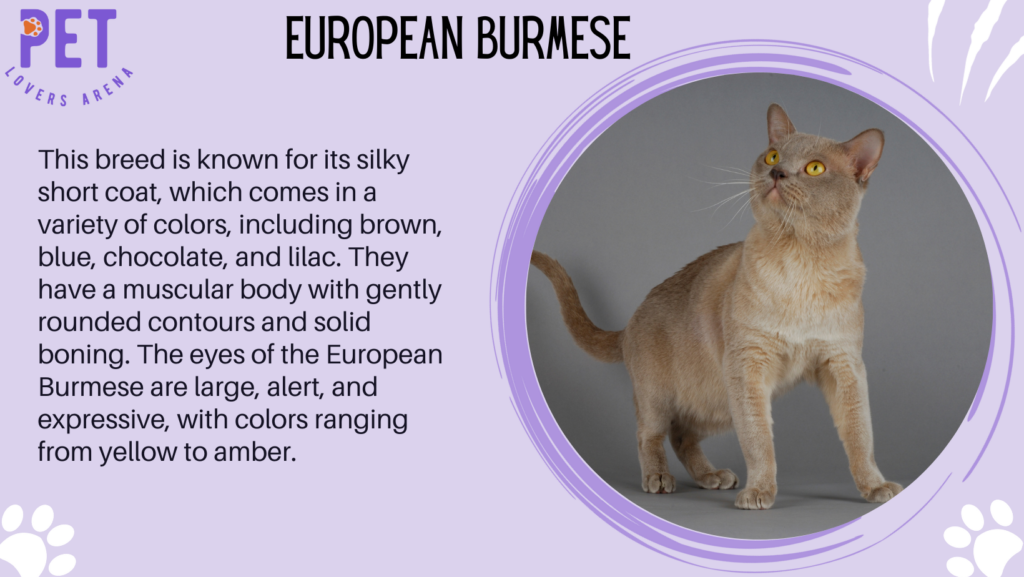
This breed is known for its silky short coat, which comes in a variety of colors, including brown, blue, chocolate, and lilac. They have a muscular body with gently rounded contours and solid boning. The eyes of the European Burmese are large, alert, and expressive, with colors ranging from yellow to amber.
- Native Habitat: Europe
- Scientific Name: Felis catus
- Size: In terms of size, the European Burmese is a medium-sized cat breed. They typically weigh between 7-12 pounds.
- Diet: They require a balanced diet that is high in protein and low in carbohydrates. Feeding them high-quality cat food is important to ensure they get all the nutrients they need to stay healthy.
- Lifespan: The European Burmese has a lifespan of 10-15 years.
31. Havana Brown
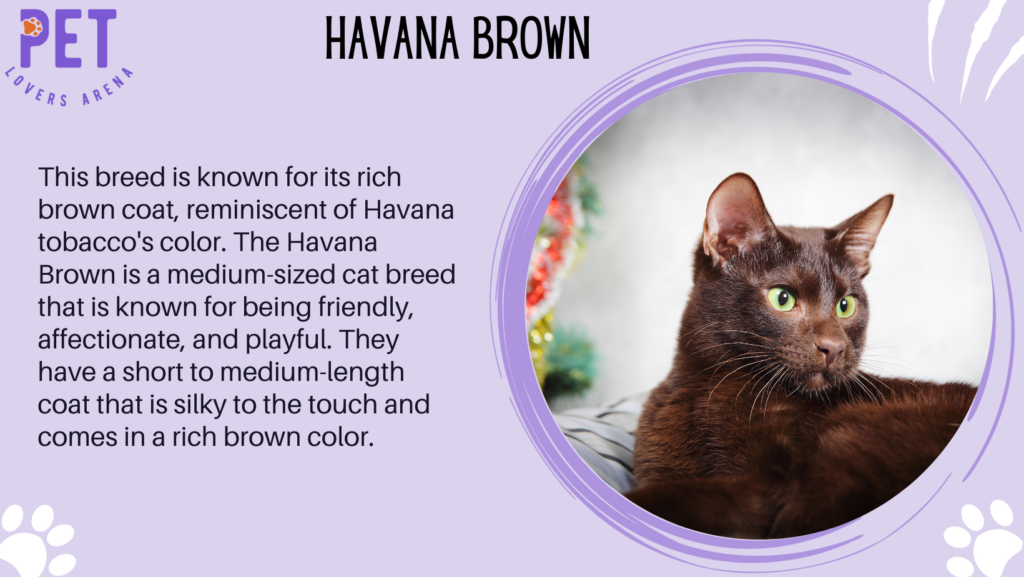
This breed is known for its rich brown coat, reminiscent of Havana tobacco’s color. The Havana Brown is a medium-sized cat breed that is known for being friendly, affectionate, and playful. They have a short to medium-length coat that is silky to the touch and comes in a rich brown color. Their eyes are a striking shade of green, which adds to their exotic appearance.
- Native Habitat: England
- Scientific Name: Felis catus
- Size: Male Havana Browns typically weigh between 8 and 12 pounds, while females are smaller, weighing in at under 8 pounds.
- Lifespan: On average, this breed has a lifespan of 8 to 13 years.
- Diet: Havana Brown is a carnivore and requires a diet that is high in protein. You can feed them a combination of wet and dry food or a raw food diet if that’s your preference. Be sure to consult with your veterinarian to ensure your cat gets all the nutrients it needs.
32. Khao Manee
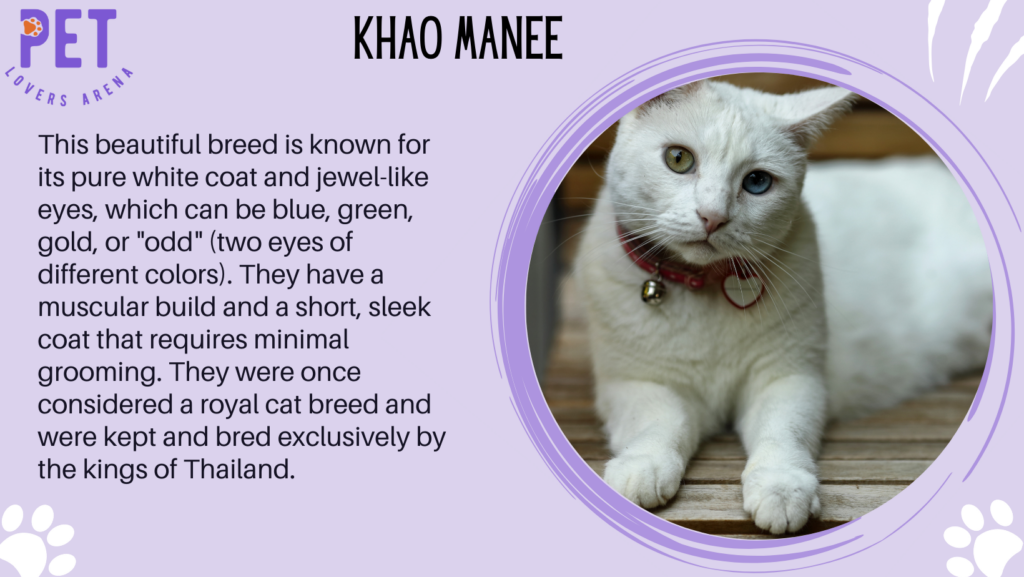
This beautiful breed is known for its pure white coat and jewel-like eyes, which can be blue, green, gold, or “odd” (two eyes of different colors). They have a muscular build and a short, sleek coat that requires minimal grooming. They were once considered a royal cat breed and were kept and bred exclusively by the kings of Thailand.
- Native Habitat: Thailand
- Scientific Name: Felis catus.
- Diet: Khao Manee is a carnivore and requires a diet rich in animal protein. High-quality commercial cat food is an excellent choice for this breed, but you can also feed them a raw or homemade diet if you prefer. It’s important to avoid feeding your Khao Manee any human foods that are toxic to cats, such as chocolate, onions, and garlic.
- Size: The Khao Manee is a medium-sized cat that typically weighs between 8 to 12 pounds.
- Lifespan: Khao Manee can live for up to 15 years or more.
33. Kurilian Bobtail
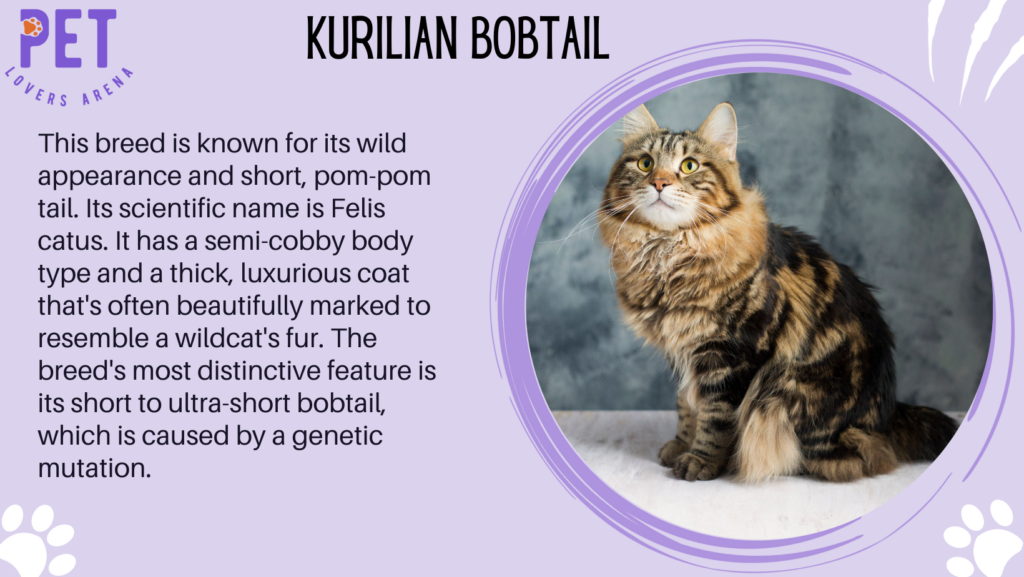
This breed is known for its wild appearance and short, pom-pom tail. Its scientific name is Felis catus. It has a semi-cobby body type and a thick, luxurious coat that’s often beautifully marked to resemble a wildcat’s fur. The breed’s most distinctive feature is its short to ultra-short bobtail, which is caused by a genetic mutation. Despite its wild appearance, the Kurilian Bobtail is gentle, friendly, and completely domesticated.
- Native Habitat: Kuril Islands, Sakhalin Island, and the Kamchatka peninsula of Russia.
- Diet: The Kurilian Bobtail is a carnivorous animal requiring a diet high in protein. It is recommended to feed your Kurilian Bobtail a diet that consists of high-quality cat food that is specifically formulated for their nutritional needs. You can also feed them raw or cooked meat, but be sure to consult with your veterinarian before making any changes to their diet.
- Size: The Kurilian Bobtail is a medium-sized cat breed that weighs between 8 to 12 pounds.
- Lifespan: The average lifespan of a Kurilian Bobtail is between 14 to 20 years.
34. Korat
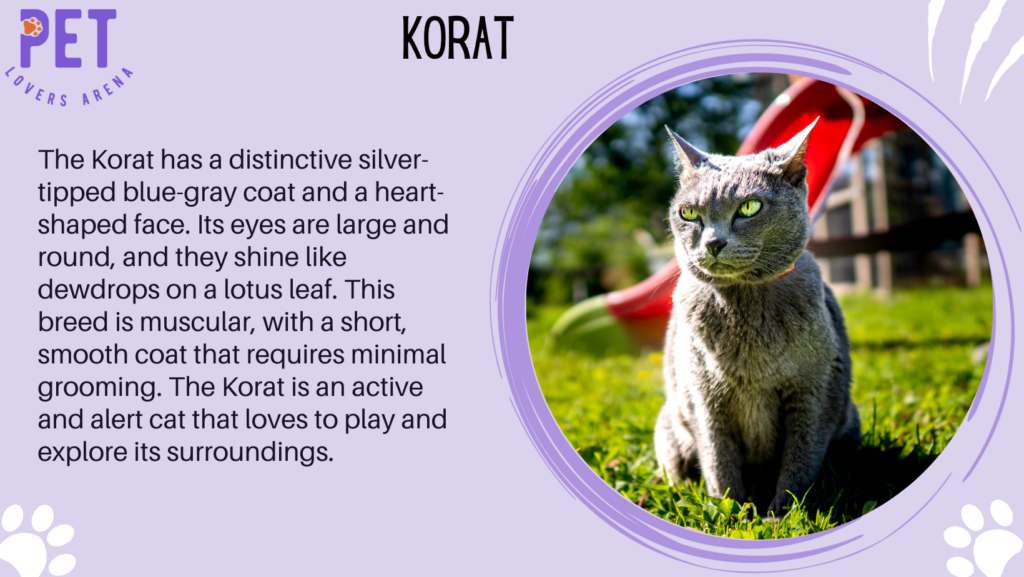
The Korat has a distinctive silver-tipped blue-gray coat and a heart-shaped face. Its eyes are large and round, and they shine like dewdrops on a lotus leaf. This breed is muscular, with a short, smooth coat that requires minimal grooming. The Korat is an active and alert cat that loves to play and explore its surroundings.
- Native Habitat: Thailand
- Scientific Name: Felis catus.
- Size: The Korat is a medium-sized cat breed that typically weighs between 6-10 pounds. It has a body length of 12-18 inches and a height of 10-14 inches.
- Diet: The Korat is an obligate carnivore, which means it requires a diet high in protein and low in carbohydrates. You should feed your Korat a high-quality cat food that is specifically formulated for its nutritional needs. You can also supplement your diet with small amounts of cooked meat or fish.
- Lifespan: The Korat has an average lifespan of 12-15 years.
35. Lykoi
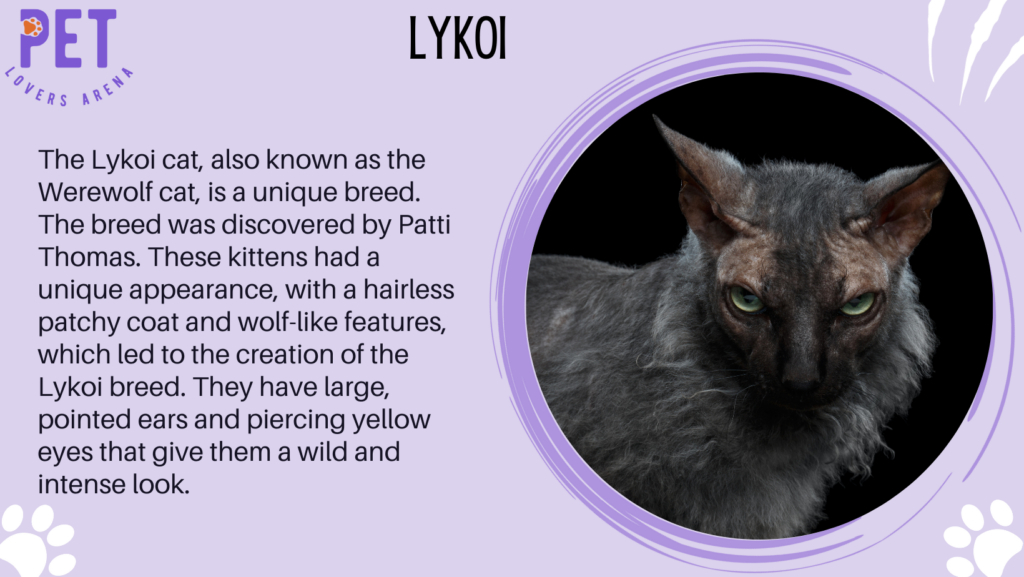
The Lykoi cat, also known as the Werewolf cat, is a unique breed. The breed was discovered by Patti Thomas. These kittens had a unique appearance, with a hairless patchy coat and wolf-like features, which led to the creation of the Lykoi breed. They have large, pointed ears and piercing yellow eyes that give them a wild and intense look.
- Native Habitat: Vonore
- Scientific Name: Felis catus.
- Diet: Lykoi cats are carnivores, and they need a diet that is high in protein. You should feed your Lykoi cat high-quality cat food that is made with real meat. You can also give them raw meat, but you should consult with your veterinarian before doing so.
- Size: Lykoi cats are medium-sized cats that can weigh anywhere from 5 to 12 pounds. They are about 11 to 14 inches in length.
- Lifespan: Lykoi cats have a lifespan of around 12 to 14 years.
36. Minskin

This rare breed is a mix of Sphynx, Munchkin, Devon Rex, and Burmese cats. The result is a small, short-legged feline with a unique appearance and personality. One of the most unique features of the Minskin is their lack of fur on their legs and belly. Minskins are known for their affectionate and outgoing personalities. They love attention and are very social with both humans and other pets.
- Native Habitat: United States
- Scientific Name: Felis catus.
- Diet: Minskin requires a balanced diet to stay healthy. They should be fed high-quality cat food that is appropriate for their age and activity level. It’s also important to provide them with fresh water at all times.
- Size: Minskin is a small cat, typically weighing between 4 and 6 pounds.
- Lifespan: They have a lifespan of 12-15 years.
37. Munchkin
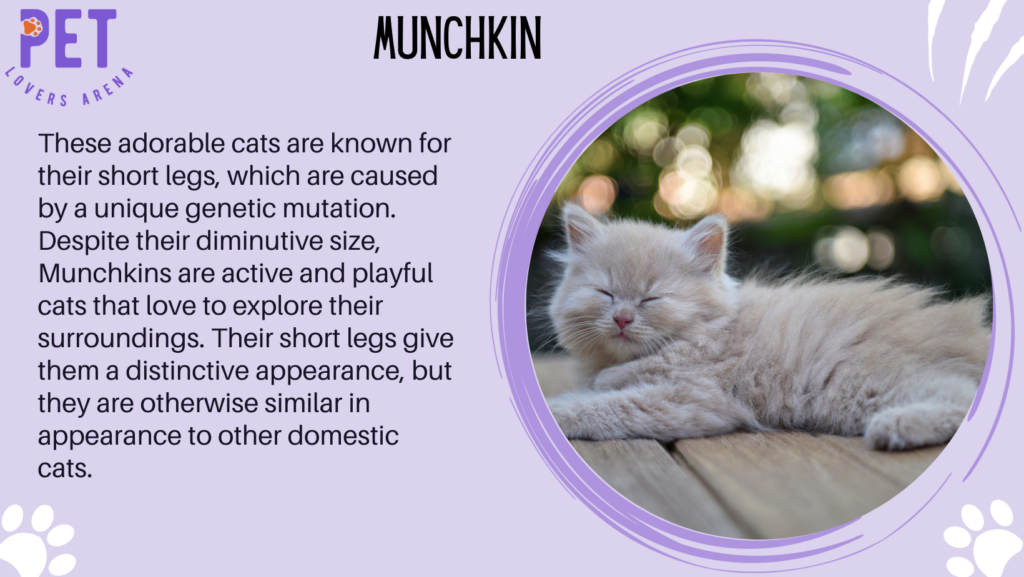
These adorable cats are known for their short legs, which are caused by a unique genetic mutation. Despite their diminutive size, Munchkins are active and playful cats that love to explore their surroundings. Their short legs give them a distinctive appearance, but they are otherwise similar in appearance to other domestic cats.
- Native Habitat: United States
- Scientific Name: Felis catus.
- Diet: Munchkins, like all cats, are obligate carnivores, which means that they require a diet that is high in animal protein. You should feed your Munchkin a high-quality commercial cat food that is formulated for their nutritional needs. You can also feed them small amounts of cooked lean meat, such as chicken or turkey.
- Size: Munchkins are small cats with an average weight of 5-9 pounds.
- Lifespan: Munchkins have a lifespan of 12-15 years.
38. Norwegian Forest Cat
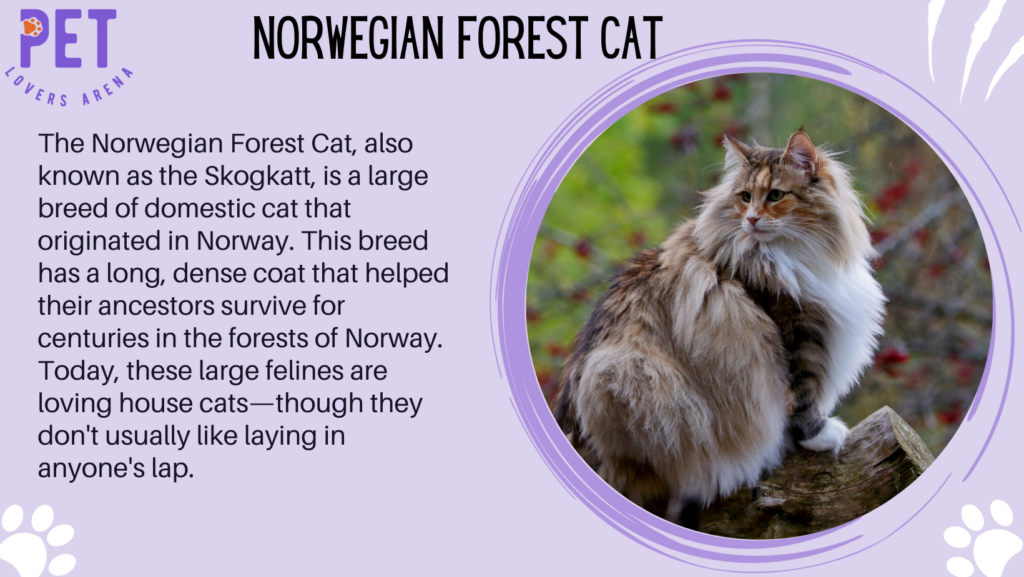
The Norwegian Forest Cat, also known as the Skogkatt, is a large breed of domestic cat that originated in Norway. This breed has a long, dense coat that helped their ancestors survive for centuries in the forests of Norway. Today, these large felines are loving house cats—though they don’t usually like laying in anyone’s lap.
- Native Habitat: Norway.
- Scientific Name: Felis catus.
- Diet: Norwegian Forest Cats are carnivorous and should consist mainly of high-quality protein sources. They also need a balanced diet that includes essential vitamins and minerals. Feeding them a mix of wet and dry food is recommended to keep them healthy and hydrated.
- Size: Norwegian Forest Cats are a large breed of cat, with males weighing between 13 and 22 pounds and females weighing between 9 and 12 pounds.
- Lifespan: The Norwegian Forest Cat has a lifespan of 14 years.
39. Scottish Fold Cat
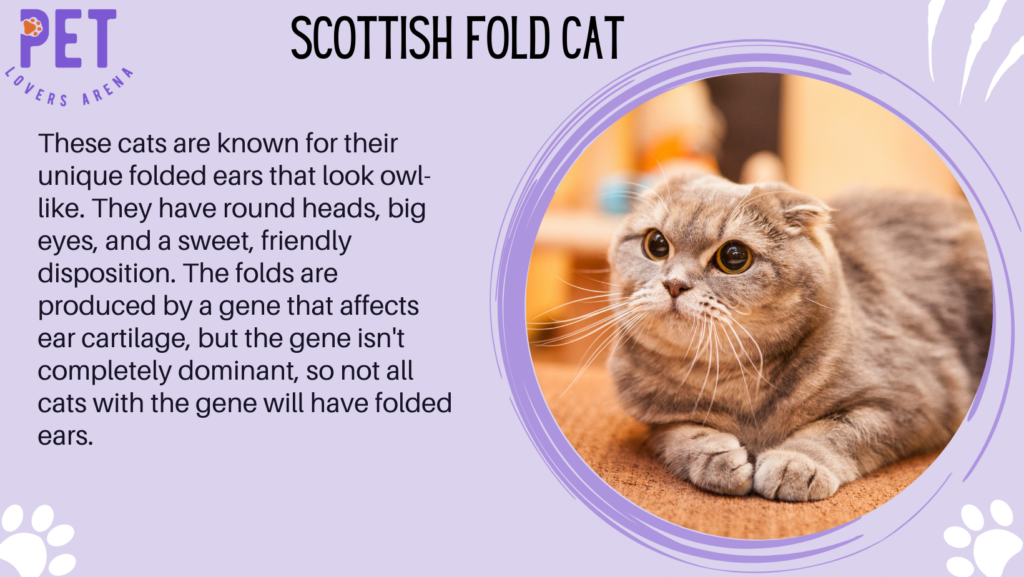
These cats are known for their unique folded ears that look owl-like. They have round heads, big eyes, and a sweet, friendly disposition. The folds are produced by a gene that affects ear cartilage, but the gene isn’t completely dominant, so not all cats with the gene will have folded ears. As the name suggests, these cats have a crooked bone structure that makes it quite difficult and painful for their development, so they get diseases from an early age.
- Native Habitat: Scotland
- Scientific Name: Felis catus.
- Size: Scottish Folds are medium-sized cats that typically weigh between 6-12 pounds.
- Diet: Scottish Folds are obligate carnivores, which means they require a diet that is high in animal protein. You should feed your Scottish Fold a high-quality cat food that is made with real meat as the first ingredient. You can also give them occasional treats, but be careful not to overfeed them.
- Lifespan: Scottish Folds have a lifespan of 12-15 years.
40. Siberian
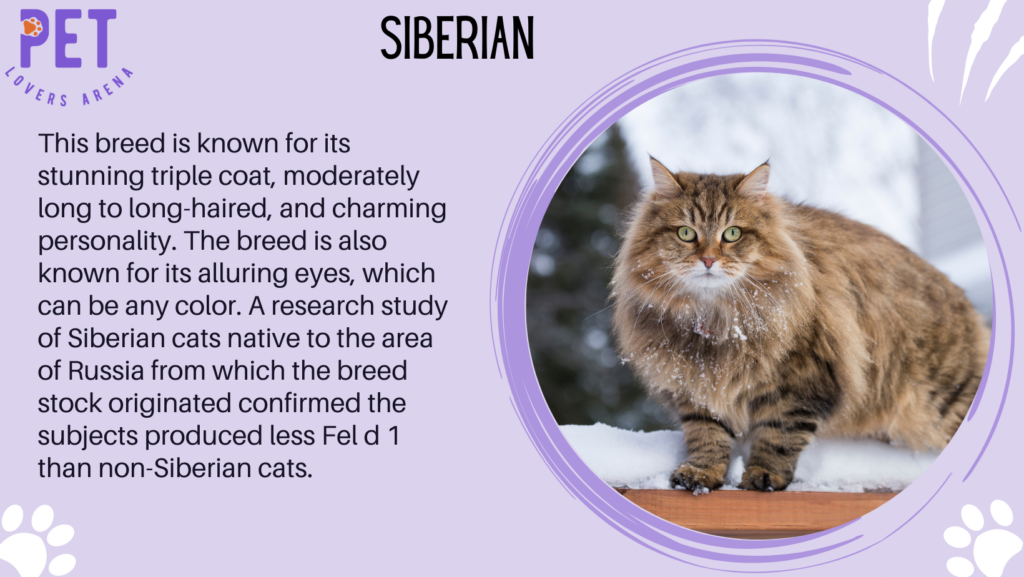
This breed is known for its stunning triple coat, moderately long to long-haired, and charming personality. The breed is also known for its alluring eyes, which can be any color. A research study of Siberian cats native to the area of Russia from which the breed stock originated confirmed the subjects produced less Fel d 1 than non-Siberian cats.
- Native Habitat: Russia
- Scientific Name: Siberian Forest Cat.
- Diet: The Siberian cat is not a picky eater and can thrive on a balanced diet of high-quality cat food. It is important to ensure that the food you provide is appropriate for its age, size, and activity level.
- Size: The Siberian cat is a medium-sized breed that can weigh anywhere from 15 to 20 pounds. It can grow up to 17 to 25 inches in length.
- Lifespan: The Siberian cat has a life expectancy of 10 to 18 years.
41. Singapura
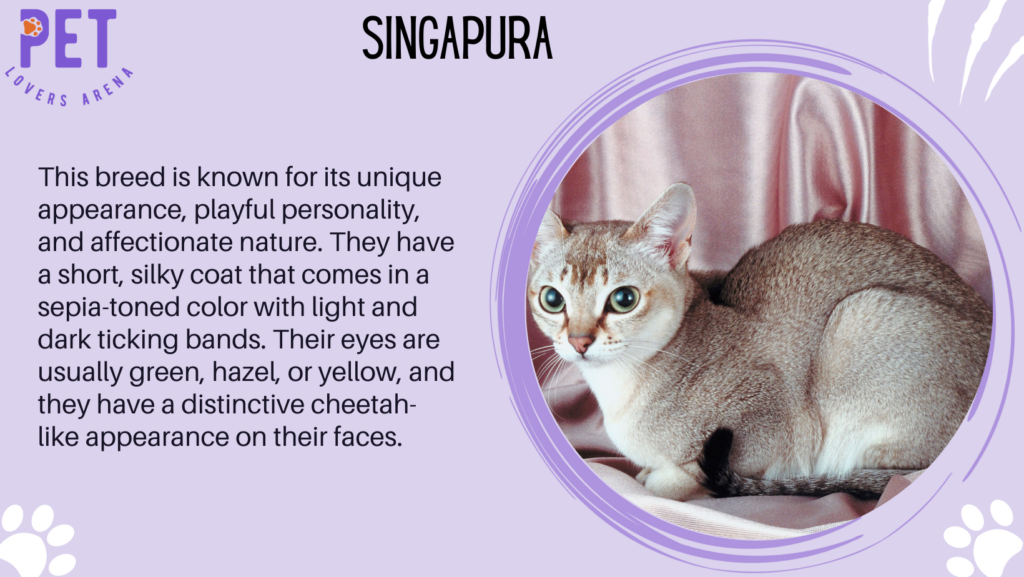
This breed is known for its unique appearance, playful personality, and affectionate nature. They have a short, silky coat that comes in a sepia-toned color with light and dark ticking bands. Their eyes are usually green, hazel, or yellow, and they have a distinctive cheetah-like appearance on their faces.
- Native Habitat: Singapore
- Scientific Name: Felis catus
- Size: Singapura is a small cat breed, weighing between 4 and 8 pounds.
- Diet: Singapura needs a balanced diet to stay healthy. They should be fed high-quality cat food that is appropriate for their age, weight, and activity level. It’s also important to provide them with plenty of fresh water and avoid feeding them table scraps or human food.
- Lifespan: The Singapura has a lifespan of 11 to 15 years.
42. Tonkinese
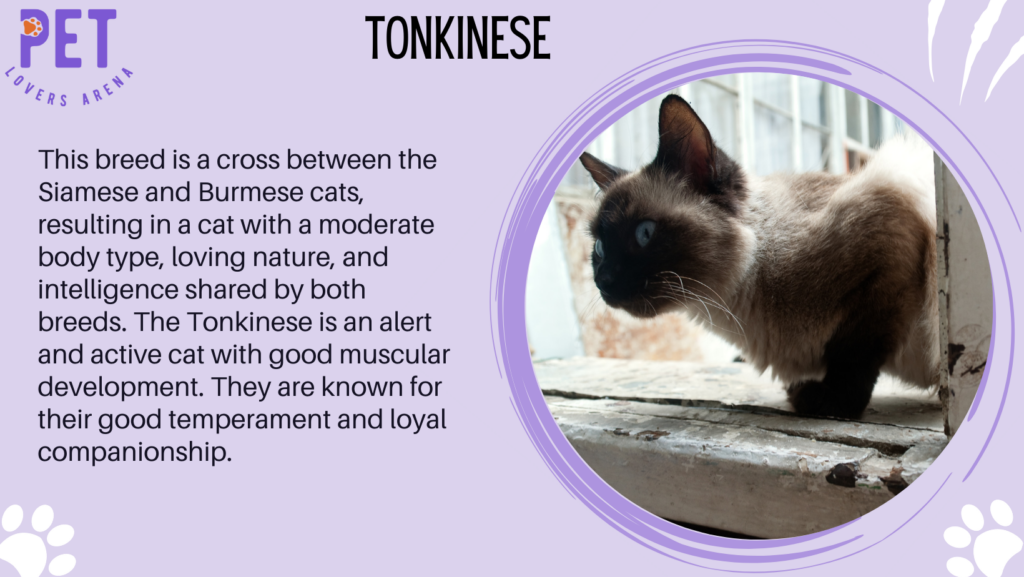
If you want a cat that has the best of both worlds, then the Tonkinese is the way to go. This breed is a cross between the Siamese and Burmese cats, resulting in a cat with a moderate body type, loving nature, and intelligence shared by both breeds. The Tonkinese is an alert and active cat with good muscular development. They are known for their good temperament and loyal companionship.
- Native Habitat: United States, Thailand, Canada
- Scientific Name: Felis catus.
- Diet: Tonkinese cats are not picky eaters, but feeding them a high-quality diet that meets their nutritional needs is important. They require a diet that is rich in protein, and it’s recommended to feed them wet food to ensure they stay hydrated.
- Size: Tonkinese cats are medium-sized cats that weigh between 6-12 pounds.
- Lifespan: Tonkinese cats have a lifespan of 14-16 years.
43. Turkish Angora
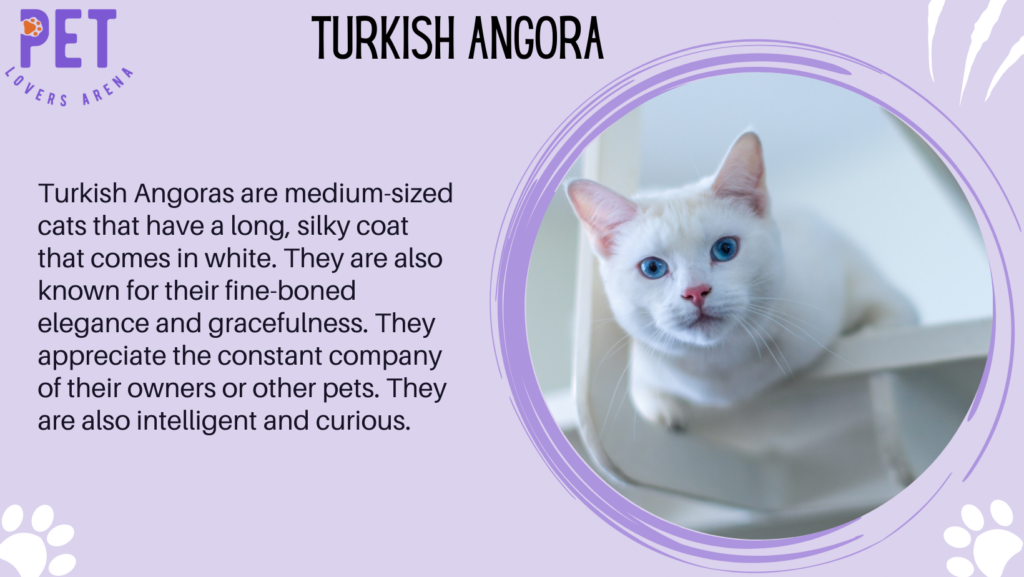
Turkish Angoras are medium-sized cats that have a long, silky coat that comes in white. They are also known for their fine-boned elegance and gracefulness. They appreciate the constant company of their owners or other pets. They are also intelligent and curious, which makes them an excellent choice for those who enjoy playing and interacting with their pets.
- Native Habitat: Turkey
- Size: Turkish Angoras are medium-sized cats that typically weigh between 5 to 10 pounds. They have a long, lean body with a long, fluffy tail.
- Diet: Turkish Angoras require a balanced diet that is rich in protein and other essential nutrients. High-quality cat food is recommended to meet their nutritional needs. It’s also essential to always provide them with fresh water to ensure they stay hydrated.
- Lifespan: Turkish Angoras have a lifespan of around 9 to 14 years.
44. Turkish Van
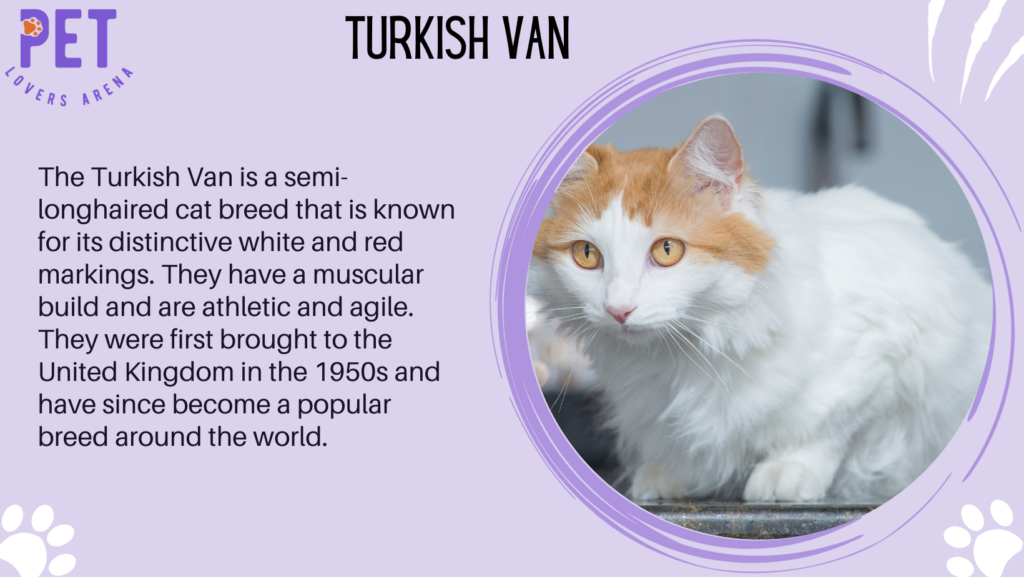
The Turkish Van is a semi-longhaired cat breed that is known for its distinctive white and red markings. They have a muscular build and are athletic and agile. They were first brought to the United Kingdom in the 1950s and have since become a popular breed around the world. They are primarily white with colored markings on their face and tails only.
- Native Habitat: Turkey
- Scientific Name: Felis catus.
- Diet: Turkish Van is a carnivore and requires a diet that is high in protein. Feeding them a balanced diet that includes wet and dry food is important to ensure they get all the nutrients they need.
- Size: Turkish Van is a large breed of cat. Males can weigh up to 20 pounds, while females typically weigh between 7 and 12 pounds.
- Lifespan: The Turkish Van can live up to 17 years.
45. Russian Blue
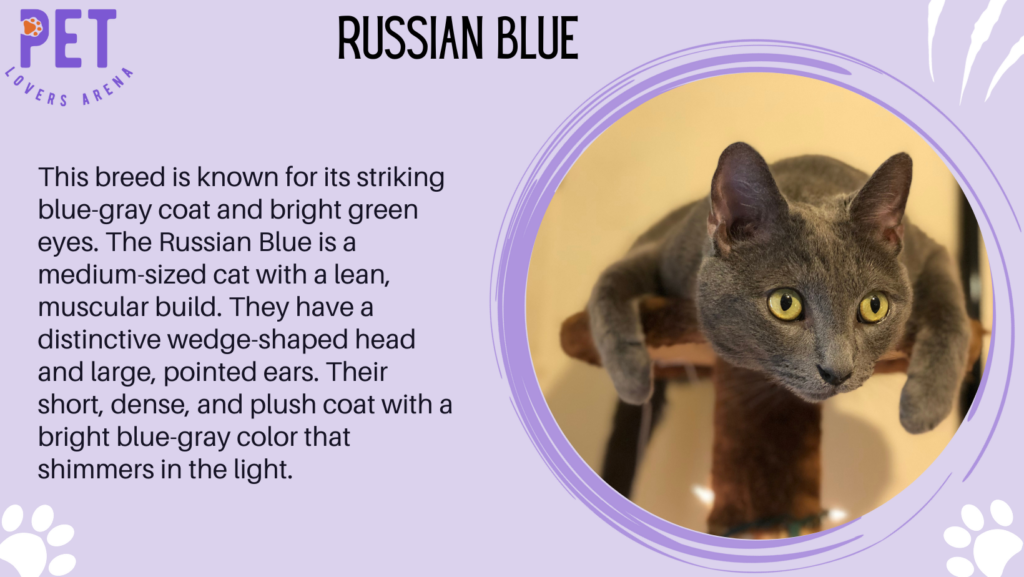
This breed is known for its striking blue-gray coat and bright green eyes. The Russian Blue is a medium-sized cat with a lean, muscular build. They have a distinctive wedge-shaped head and large, pointed ears. Their short, dense, and plush coat with a bright blue-gray color that shimmers in the light. They have a sweet and gentle personality and are known for their intelligence and affectionate nature.
- Native Habitat: Archangel Isles
- Scientific Name: Felis catus.
- Size: Russian Blues are medium-sized cats, typically weighing between 8 and 12 pounds. They have a long, lean body and a graceful, athletic build.
- Diet: Russian Blues are carnivores, and their diet should consist primarily of high-quality meat-based cat food. They also enjoy the occasional treat, such as cooked chicken or fish.
- Lifespan: The average lifespan of a Russian Blue is 10 to 15 years.
46. Siamese
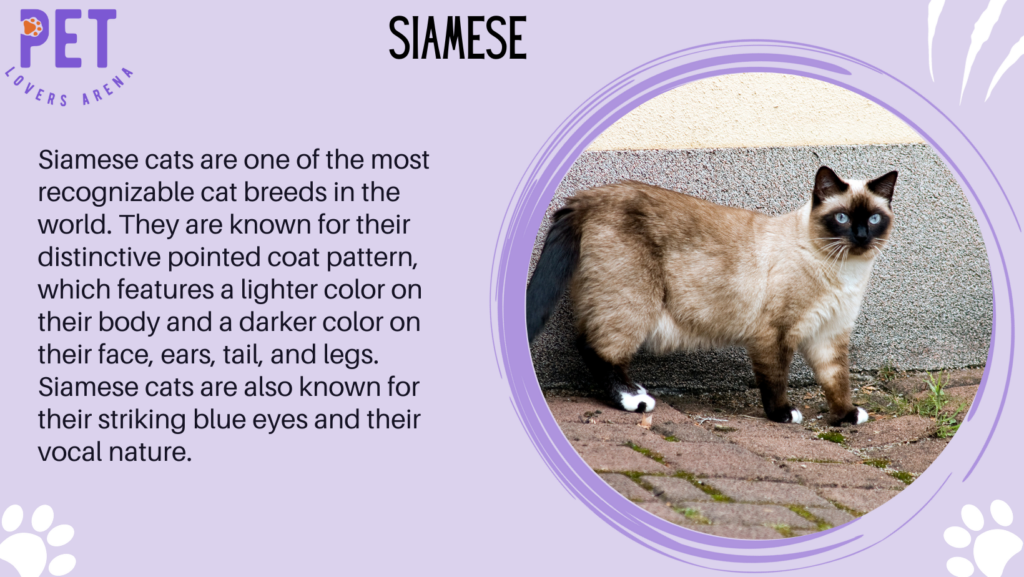
Siamese cats are one of the most recognizable cat breeds in the world. They are known for their distinctive pointed coat pattern, which features a lighter color on their body and a darker color on their face, ears, tail, and legs. Siamese cats are also known for their striking blue eyes and their vocal nature.
- Native Habitat: Thailand
- Scientific Name: Felis catus.
- Size: Siamese cats are medium-sized, with males typically weighing between 8-12 pounds and females weighing between 6-10 pounds.
- Diet: Siamese cats require a balanced diet that is high in protein and low in carbohydrates. They are carnivores and should be fed a diet that includes meat as the primary ingredient. It is important to feed Siamese cats high-quality cat food that is specifically formulated for their nutritional needs.
- Lifespan: Siamese cats have an average lifespan of 12-15 years.
47. Birman
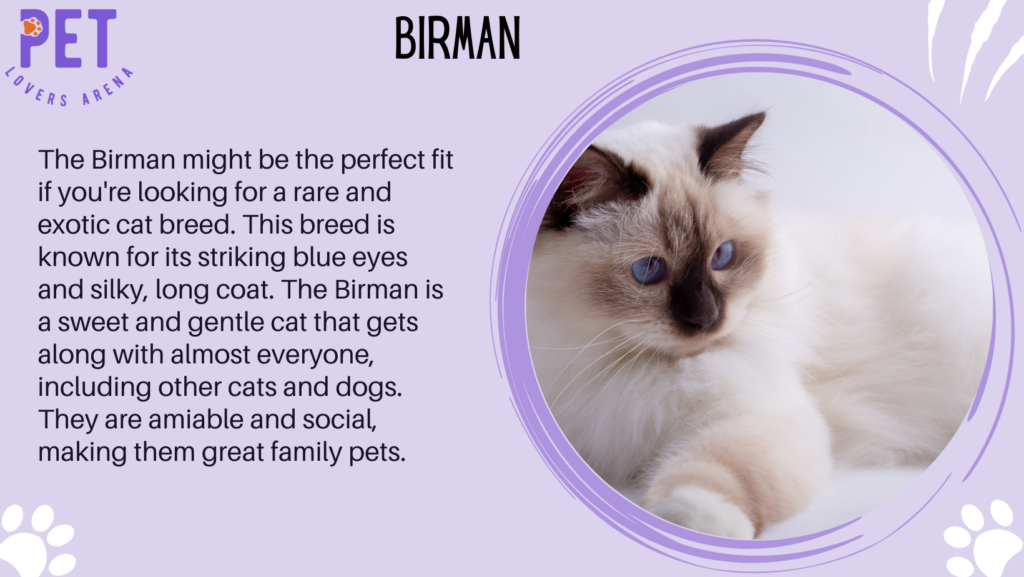
The Birman might be the perfect fit if you’re looking for a rare and exotic cat breed. This breed is known for its striking blue eyes and silky, long coat. The Birman is a sweet and gentle cat that gets along with almost everyone, including other cats and dogs. They are amiable and social, making them great family pets.
- Native Habitat: Burma
- Scientific Name: Felis catus.
- Size: The Birman is a medium-sized cat that can become quite large. Males typically weigh between 8 and 12 pounds, while females weigh between 6 and 8 pounds.
- Diet: Birmans are generally healthy cats and do not require a special diet. However, they do need a well-balanced diet that meets their nutritional needs. It’s important to provide them with high-quality cat food that is appropriate for their age, size, and activity level.
- Lifespan: Birmans have a relatively long lifespan of 12 to 16 years.
48. Somali
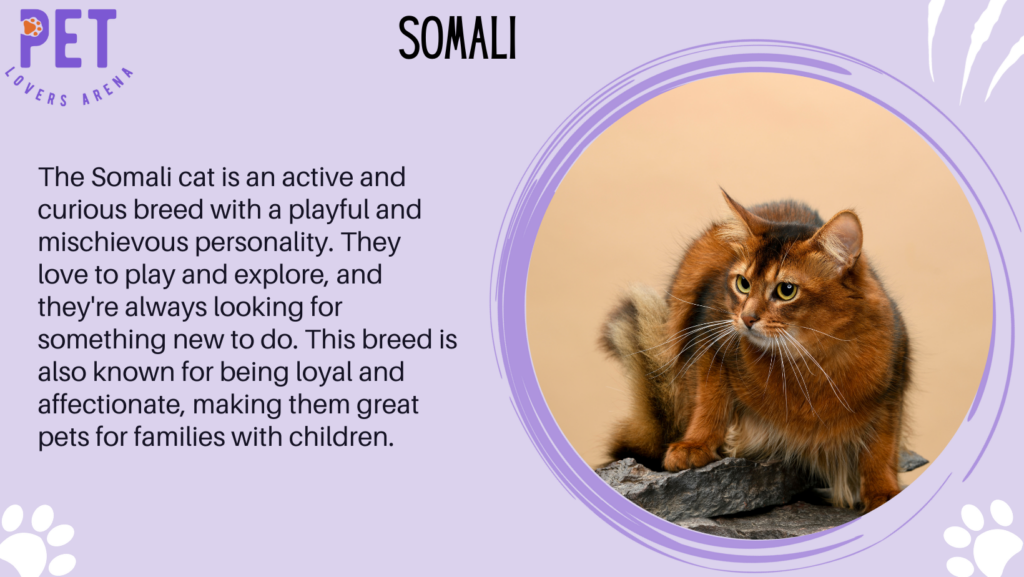
The Somali cat is an active and curious breed with a playful and mischievous personality. They love to play and explore, and they’re always looking for something new to do. This breed is also known for being loyal and affectionate, making them great pets for families with children. The coats of these cats are very soft to the touch in comparison to other cats. If you look closely, you will find four to twenty colors on each on each hair.
- Native Habitat: Australia
- Scientific Name: Felis catus.
- Size: Somali cats are medium-sized cats, with males typically weighing between 8-12 pounds and females weighing between 6-9 pounds.
- Diet: Somali cats are obligate carnivores, which means they require a diet that’s high in protein and low in carbohydrates. You should feed your Somali cat a high-quality, grain-free cat food that’s made from real meat and doesn’t contain any fillers or artificial ingredients.
- Lifespan: Somali cats have a lifespan of around 12-14 years.
49. German Rex
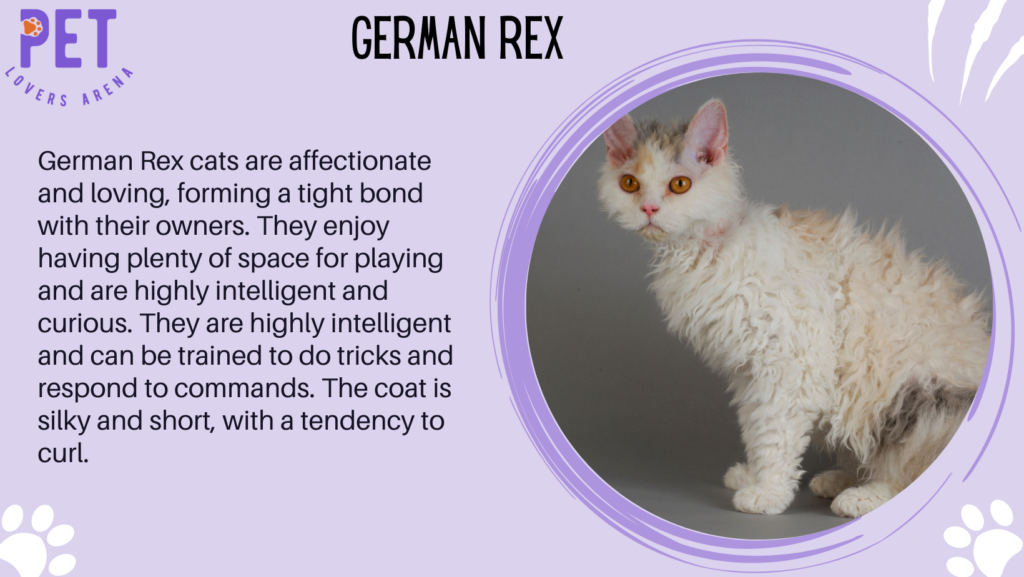
German Rex cats are affectionate and loving, forming a tight bond with their owners. They enjoy having plenty of space for playing and are highly intelligent and curious. They are highly intelligent and can be trained to do tricks and respond to commands. The coat is silky and short, with a tendency to curl. The whiskers also curl, though less strongly than in the Cornish Rex.
- Native Habitat: Germany
- Scientific Name: Felis catus.
- Diet: German Rex requires a balanced diet that is rich in protein. High-quality cat food is recommended, along with occasional treats. It is important to monitor their food intake to prevent obesity, which can lead to health problems.
- Size: The German Rex is a medium-sized cat with a weight range of less than 8 pounds for both males and females.
- Lifespan: The German Rex has an average lifespan of 12-15 years.
50. Manx
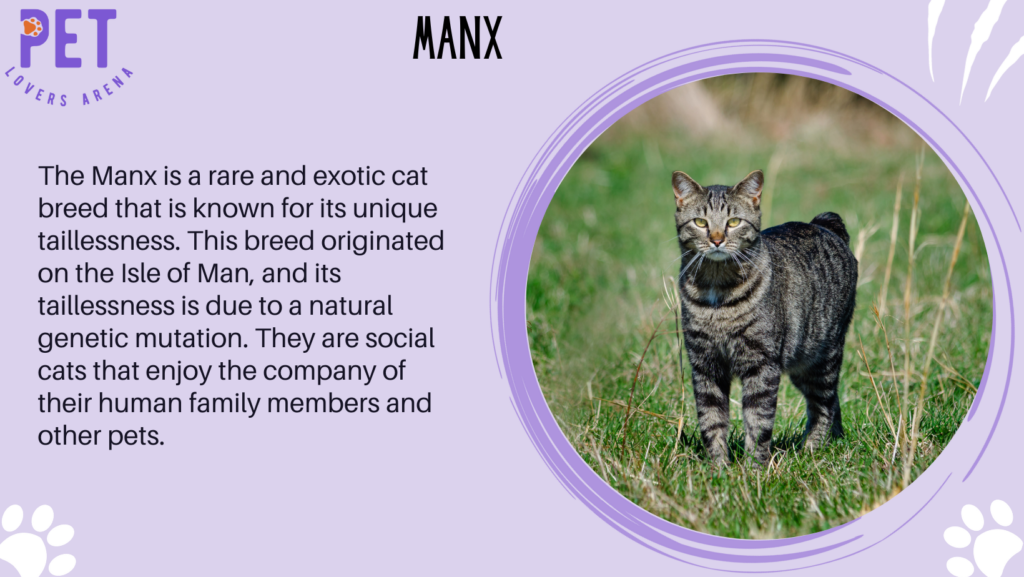
The Manx is a rare and exotic cat breed that is known for its unique taillessness. This breed originated on the Isle of Man, and its taillessness is due to a natural genetic mutation. They are social cats that enjoy the company of their human family members and other pets. These cats are skilled hunters who are in demand by farmers facing rodent issues.
- Native Habitat: Isle of Man
- Scientific Name: Felis catus.
- Diet: When it comes to diet, Manx cats require a balanced diet that is high in protein. They should be fed a diet that consists of high-quality cat food that is specifically formulated for their age, weight, and activity level. It is also important to provide them with fresh water at all times.
- Size: Manx cats have a medium-sized, muscular build and can weigh anywhere from 8-12 pounds.
- Lifespan: Manx cats have a lifespan of 9-13 years.
51. Japanese Bobtail
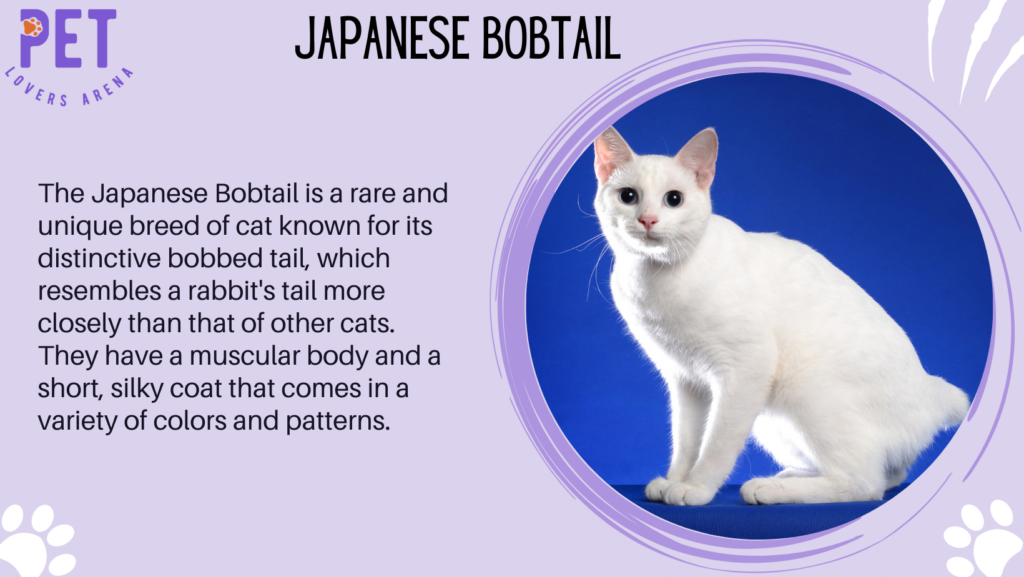
The Japanese Bobtail is a rare and unique breed of cat known for its distinctive bobbed tail, which resembles a rabbit’s tail more closely than that of other cats. They have a muscular body and a short, silky coat that comes in a variety of colors and patterns. Their most distinctive feature is their short, bobbed tail caused by a genetic mutation. Bobcats are said to be lucky cats as they bring prosperity and happiness to their owners.
- Native Habitat: Japan
- Scientific Name: Felis catus.
- Size: Japanese Bobtails are small to medium-sized cats weighing between 6-12 pounds.
- Diet: Japanese Bobtails are obligate carnivores, which means they require a diet that is high in protein. A diet consisting of high-quality canned or dry food is recommended, supplemented with occasional treats.
- Lifespan: The average lifespan of a Japanese Bobtail is 12-16 years.
52. European Shorthair
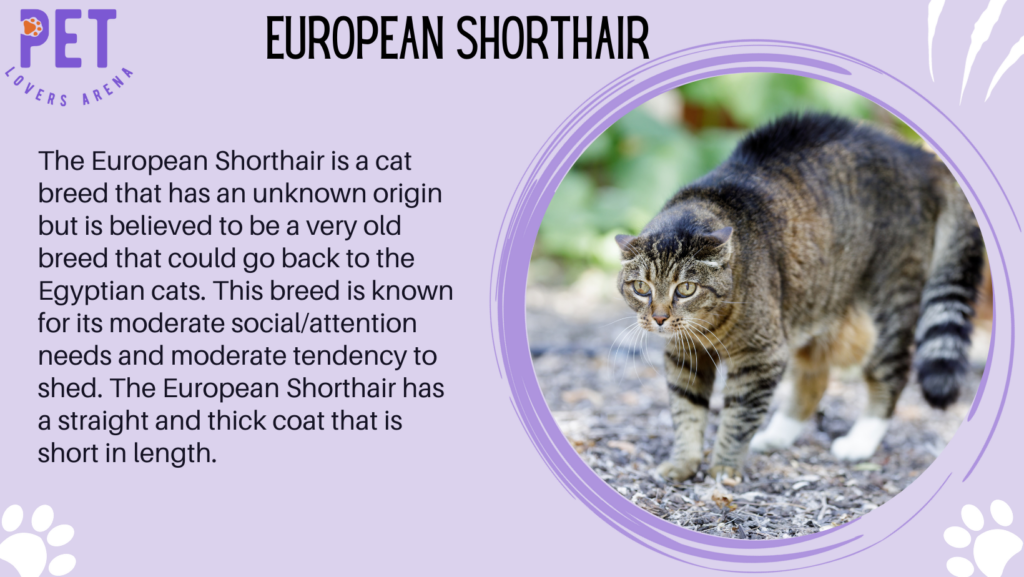
The European Shorthair is a cat breed that has an unknown origin but is believed to be a very old breed that could go back to the Egyptian cats. This breed is known for its moderate social/attention needs and moderate tendency to shed. The European Shorthair has a straight and thick coat that is short in length.
- Native Habitat: Europe.
- Scientific Name: Felis catus.
- Diet: The European Shorthair needs a balanced diet that is rich in protein, vitamins, and minerals. It should be fed with high-quality cat food that is appropriate for its age, weight, and activity level. This breed is prone to obesity, so it is important to monitor its food intake and provide regular exercise.
- Size: The European Shorthair is a medium to large-sized cat breed. Females weigh around 12-15 pounds, while males weigh 15 pounds or more.
- Lifespan: The European Shorthair has a lifespan that ranges from 15-20 years.
53. Exotic Shorthair
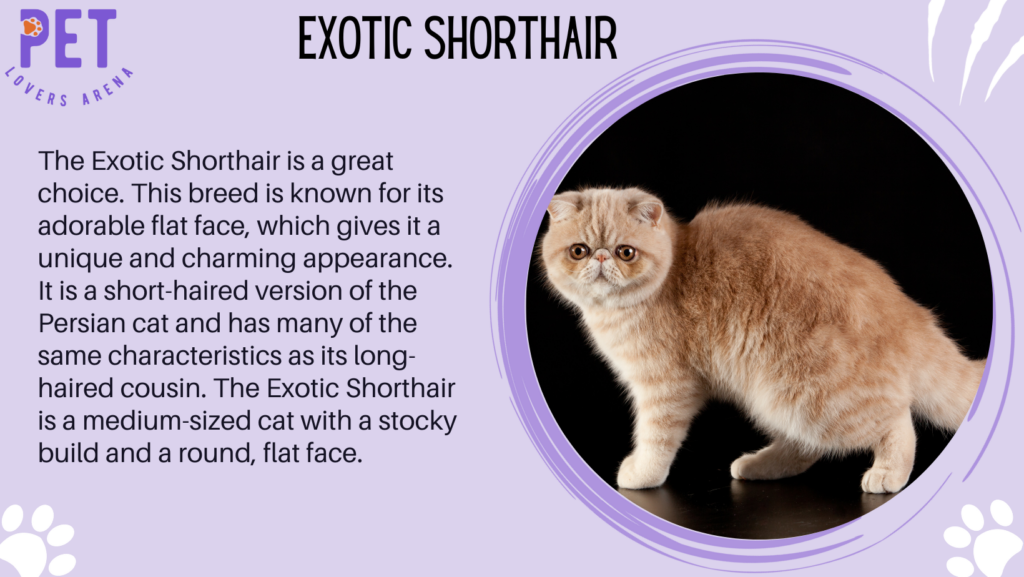
If you’re looking for a cat that’s a little bit different, the Exotic Shorthair is a great choice. This breed is known for its adorable flat face, which gives it a unique and charming appearance. It is a short-haired version of the Persian cat and has many of the same characteristics as its long-haired cousin. The Exotic Shorthair is a medium-sized cat with a stocky build and a round, flat face.
- Native Habitat: United States
- Scientific Name: Felis catus.
- Size: The Exotic Shorthair is a medium-sized cat breed that typically weighs between 8 and 15 pounds.
- Diet: The Exotic Shorthair is a carnivorous animal requiring a diet high in protein. Feeding your cat a balanced diet that includes wet and dry food is important. You should also provide your cat with fresh water at all times.
- Lifespan: The Exotic Shorthair has a lifespan of up to 15 years.
54. Aegean
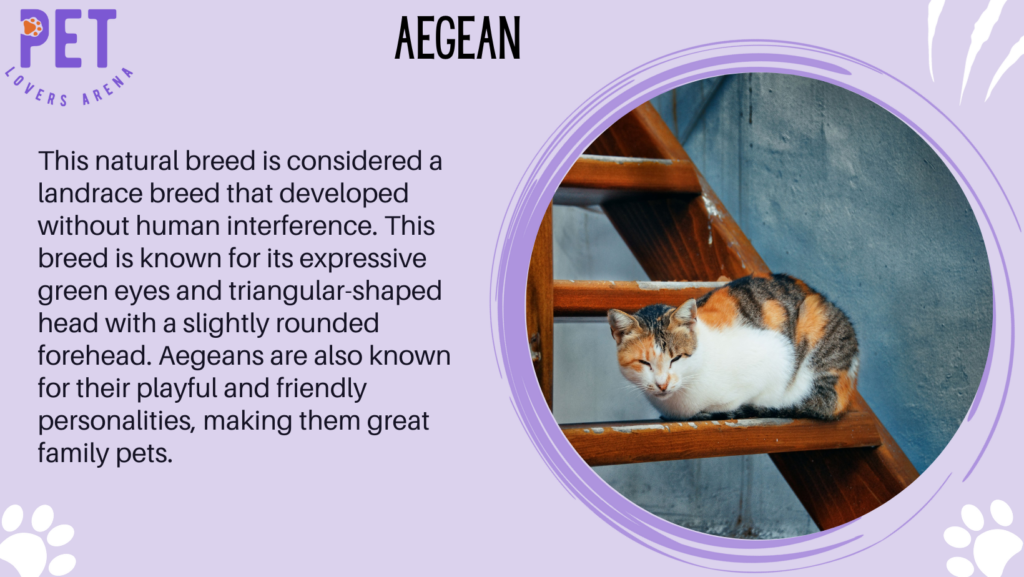
This natural breed is considered a landrace breed that developed without human interference. This breed is known for its expressive green eyes and triangular-shaped head with a slightly rounded forehead. Aegeans are also known for their playful and friendly personalities, making them great family pets.
- Native Habitat: Cycladic Islands in Greece and western Turkey.
- Scientific Name: Felis catus.
- Diet: Aegeans are obligate carnivores and require a diet that is high in protein. You should feed your Aegean cat a high-quality cat food that contains real meat as the first ingredient. You can also supplement your cat’s diet with small amounts of cooked meat or fish, but be sure to avoid feeding your cat any foods that are toxic to cats, such as onions, garlic, and chocolate.
- Size: Aegean cats are medium-sized cats that typically weigh between 7 and 10 pounds.
- Lifespan: They have a lifespan of around 9 to 12 years.
55. Caracal
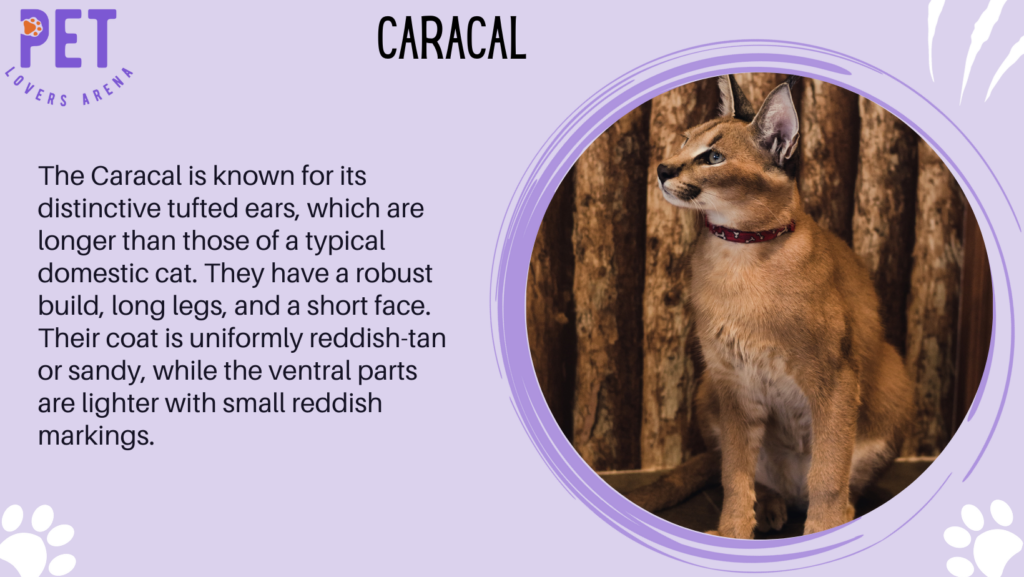
The Caracal is known for its distinctive tufted ears, which are longer than those of a typical domestic cat. They have a robust build, long legs, and a short face. Their coat is uniformly reddish-tan or sandy, while the ventral parts are lighter with small reddish markings. Both sexes (male and female) become sexually mature by the time they are one year old and breed throughout the year.
- Native Habitat: Regions of Africa and from the Arabian Peninsula through northwest India.
- Scientific Name: Felis caracal
- Diet: Caracals are carnivorous and primarily feed on small mammals, birds, and reptiles. As pets, they require a diet that mimics their natural prey, which can include raw meat and organs.
- Size: They are the heaviest of the small African cats weighing from 25-40 pounds
- Lifespan: Caracals can live up to 12 years in the wild.
56. Ojos Azules
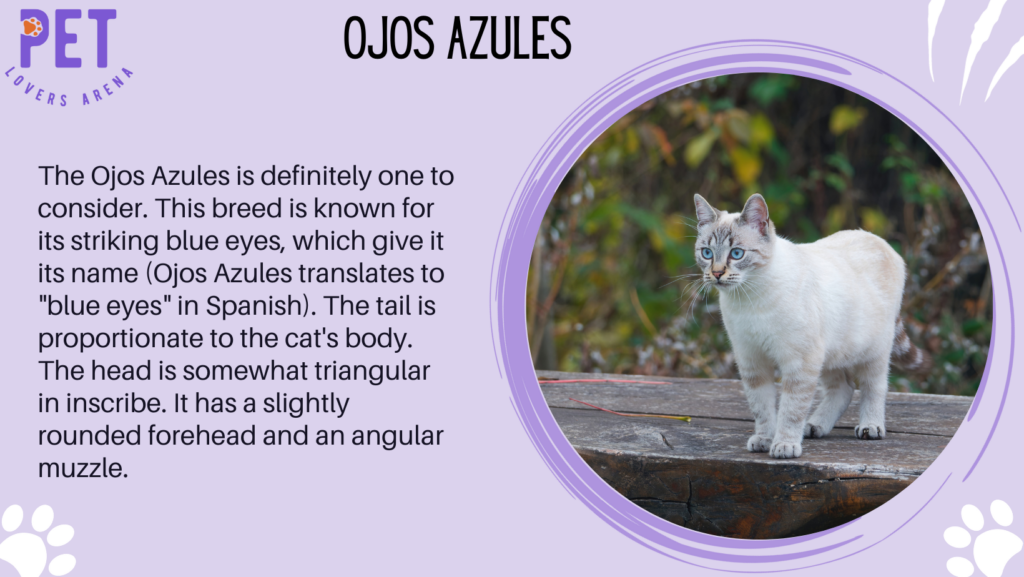
If you’re looking for a rare and unique cat breed, the Ojos Azules is definitely one to consider. This breed is known for its striking blue eyes, which give it its name (Ojos Azules translates to “blue eyes” in Spanish). The tail is proportionate to the cat’s body. The head is somewhat triangular in inscribe. It has a slightly rounded forehead and an angular muzzle.
- Scientific name: Felis catus.
- Native habitat: United States
- Size: 9-12 pounds.
- Diet: High-quality cat food, supplemented with occasional treats.
- Lifespan: 10-12 years.
57. Napoleon or Minuet
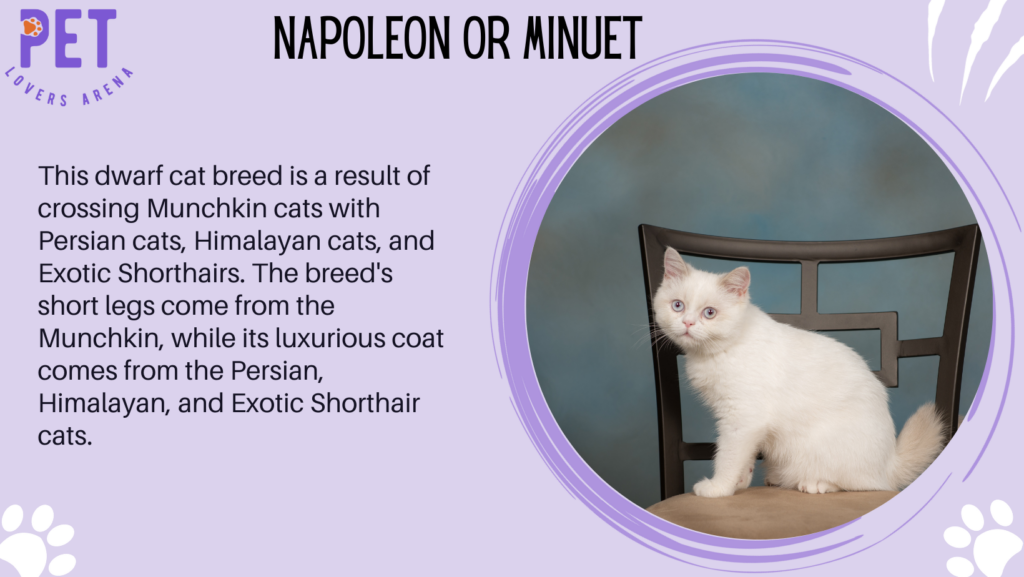
If you’re looking for a cat that is cute, charming, and affectionate, you might want to consider the Napoleon or Minuet cat breed. This dwarf cat breed is a result of crossing Munchkin cats with Persian cats, Himalayan cats, and Exotic Shorthairs. The breed’s short legs come from the Munchkin, while its luxurious coat comes from the Persian, Himalayan, and Exotic Shorthair cats.
- Native Habitat: Napoleon or Minuet does not have a native habitat.
- Scientific Name: Felis catus.
- Size: Napoleon or Minuet cats are small to medium-sized, weighing 5-9 pounds.
- Diet: The Napoleon or Minuet cat breed requires a balanced diet that is rich in protein, vitamins, and minerals. You can feed your cat a high-quality commercial cat food or prepare homemade meals that meet its nutritional needs. Make sure to consult with your veterinarian to determine the best diet for your cat.
- Lifespan: The Napoleon or Minuet cat breed has a lifespan of 9-15 years.
58. Ragamuffin
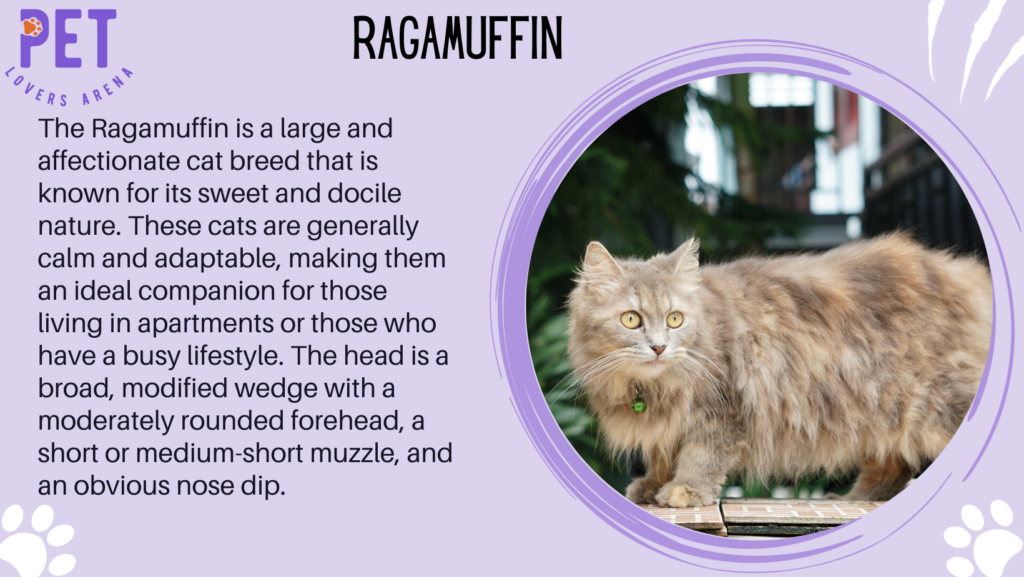
The Ragamuffin is a large and affectionate cat breed that is known for its sweet and docile nature. These cats are generally calm and adaptable, making them an ideal companion for those living in apartments or those who have a busy lifestyle. The head is a broad, modified wedge with a moderately rounded forehead, a short or medium-short muzzle, and an obvious nose dip. The muzzle is wide with puffy whisker pads.
- Native Habitat: United States
- Scientific Name: Felis catus.
- Diet: The Ragamuffin is a carnivorous animal requiring a diet high in protein. They are recommended to be fed high-quality cat food formulated for their specific life stage and needs. They may also enjoy occasional treats, but these should be given in moderation.
- Size: The Ragamuffin is a large cat breed, with males sometimes reaching up to 20 pounds. Females are also large, typically weighing over 12 pounds.
- Lifespan: The Ragamuffin has a lifespan of around 12-16 years, which is similar to other domestic cat breeds. However, with proper care and attention, they may be able to live longer.
59. Selkirk Rex
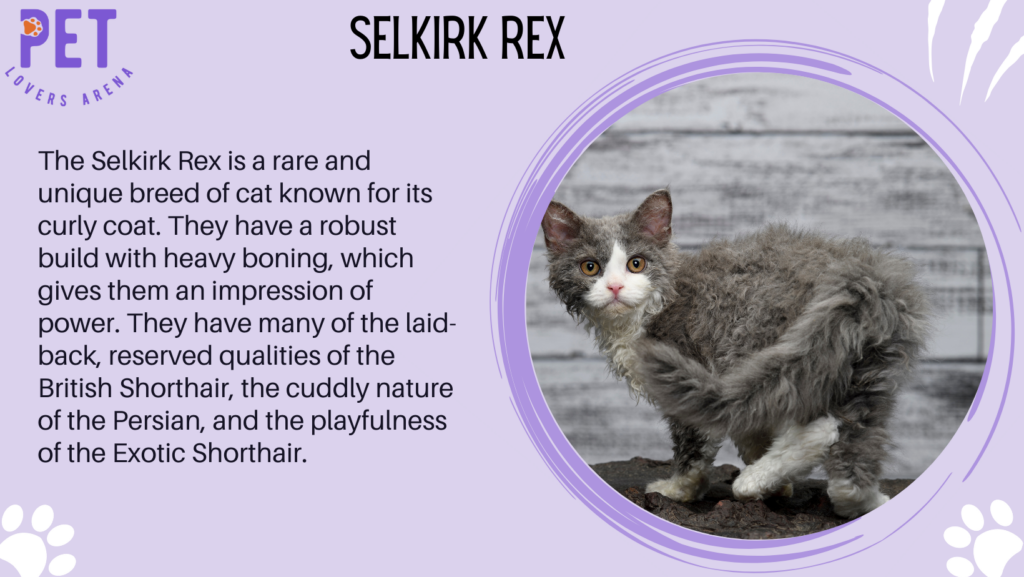
The Selkirk Rex is a rare and unique breed of cat known for its curly coat. They have a robust build with heavy boning, which gives them an impression of power. They have many of the laid-back, reserved qualities of the British Shorthair, the cuddly nature of the Persian, and the playfulness of the Exotic Shorthair. They are known for being affectionate and friendly, making them great family pets.
- Scientific Name: Felis catus.
- Native Habitat: Montana
- Size: The Selkirk Rex is a medium to large-sized cat with a weight range of over 16 lbs
- Diet: The Selkirk Rex’s diet should consist of high-quality cat food that is appropriate for their age, weight, and activity level. Feeding them a balanced diet that includes protein, fat, and carbohydrates is essential. It is also important to provide them with fresh water at all times.
- Lifespan: The Selkirk Rex has a lifespan of over 15 years.
FAQ’s
The rarest color of a cat is the pure white cat with blue eyes. This is due to a genetic mutation that causes the cat to lack pigmentation in the fur and eyes.
A cat breed is considered ‘exotic’ if it is not commonly found in households and has unique physical characteristics that set it apart from other breeds. Exotic cat breeds may also have a rare or unusual coat pattern or color.
The clouded leopard is one of the most difficult cat breeds to find, as it is a rare and endangered species native to Southeast Asia. It is illegal to own a clouded leopard as a pet in most countries.
Some domesticated wild cat breeds include the Bengal, the Savannah, and the Chausie. These breeds have been selectively bred to have a wild appearance while still maintaining a domesticated temperament.
Conclusion
In conclusion, rare exotic cat breeds can make for fascinating and unique pets. From the Devon Rex with its impish personality and large ears to the Norwegian Forest Cat with its long, thick fur, there are many rare breeds to choose from. When considering getting a rare exotic cat, it’s important to research and understand each breed’s specific needs and characteristics.
Meet Fabian Wright, our guide into the animal realm at PetLoversArena.com. Having served as an Animal Care Specialist for the Ruwenzori Team at the Kansas City Zoo, he prioritizes conserving exotic species by replicating their habitats. Fabian aspires to share captivating stories of creatures, big and small, through PetLoversArena.com.

